#Kyoto Fushimi Port Park
Explore tagged Tumblr posts
Video
tumblr
“ beautiful morning “ // © macchan358
Music: BGM maker - Kimi No Irumachi
#🗾京都 伏見港公園#Kyoto Fushimi Port Park#Kyoto Prefecture#Japan#cityscape#landscape#spring#Sakura#cherry blossom#river#4K#8K#fpv#reels#aesthetics#wanderlust#explore#follow#discover
368 notes
·
View notes
Text
Luxury Tours in Japan for you

Uncovering the Magic of Japan with Luxury Tours
Japan is a land of mystery and beauty, and luxury tour operators can help you uncover its hidden gems. From the bustling streets of Tokyo to the tranquil landscapes of Kyoto, discover the culture, history, and beauty that Japan has to offer. With a range of activities such as hot spring visits, tea ceremonies and cooking classes, these tours offer an unforgettable experience for all kinds of travelers Additionally, with experienced guides and luxurious accommodations, luxury tour operators will ensure that your journey to Japan is an unforgettable one. Explore its ancient temples and shrines, sample its delicious cuisine, or take in its stunning views - whatever you choose to do on your trip, luxury tour operators will make sure it's a magical experience!
What are Some of Japan's Most Popular Cities to Explore with Luxury Tours?
Japan is a country with a rich history and culture that has captivated the attention of travelers from all over the world. With its stunning landscapes, bustling cities, and unique attractions, it's no surprise that Japan is one of the most popular destinations for luxury tours. From Tokyo to Kyoto, there are countless cities in Japan that offer amazing experiences for those looking to explore with a luxurious touch. In this section, we'll take a look at some of the most popular cities in Japan for luxury tours and what they have to offer. travelers.
1) Tokyo: The center of Japan, Tokyo is the capital of Japan and home to some of the world's most iconic landmarks. From the scenic cityscapes to its bustling urban areas, there are endless opportunities for luxury tours in Tokyo. But if you're looking for a classic tour of Japan's capital, you'll find it by visiting Sensoji Temple and exploring nearby Harajuku District. With plenty to see and do, this is one of Tokyo's best-kept secrets.
2) Kyoto: Kyoto has always been one of Japan's most culturally rich cities. With its historic sites and beautiful landscapes, it's no surprise that Kyoto is a popular destination for luxury tours. For a tour of the area, you'll want to visit Fushimi Inari Shrine and see the famous red torii gates. But if you're looking for an insight into this beautiful city, try visiting Shin-kyoin-ji Temple or Fushimi Castle.Kamakura. The eastern coastal city of Kamakura is home to numerous Buddhist temples and shrines as well as museums that offer insights into Japanese history and culture.
3) Osaka: Osaka is known for its international flair, both culturally and gastronomically. For a tour of this vibrant city, visit the Osaka Museum of History or Namba Parks to see some popular attractions. But if your taste buds are calling you to try something new, consider visiting the famous Kani Doro Sushi restaurant in Namba.Kobe: Kobe is renowned as one of Japan's most historical cities with a major port and over 100 Buddhist temples and shrines.
Conclusion
Luxury tours in Japan offer an incredible opportunity to explore the country’s culture, history and natural beauty. From traditional ryokans to modern luxury hotels, these tours provide travelers with the chance to experience the best of Japan’s hospitality. . Whether you’re looking for a romantic getaway or a family vacation, luxury tours in Japan will help you make your trip one to remember. For more information, check out japan luxury tours.
0 notes
Text
Fast trains and paper cranes: a Japanese adventure
A ‘hop on, hop off’ westbound itinerary from Tokyo to Kobe by Shinkansen
With its futuristic cityscapes and tranquil temples, ancient traditions and cutting-edge luxury hotels, Japan is a country that must be seen to be believed. And, thanks to its legendary Shinkansen (also known as the Bullet Train), travel is all part of the experience. In this itinerary, we whisk you from Tokyo to the country’s waterfront cosmopolitan city, Kobe, taking in some of the country’s must-see sights en route. Prepare to be swept off your feet.
AT A GLANCE
An open-ended independent itinerary for Japan, based on flying into Tokyo to travel westbound by the world-famous Shinkansen.
Recommended scenic stop-off points include Izu, Nagoya, Ise-Shima, Nara, and Kyoto.
Highlights include luxury hotels, tranquil temples and shrines, cherry blossom tunnels, and views of Mount Fuji.
START IN STYLE: TOKYO
Tokyo is a city that never stands still; a sprawling mishmash of neighbourhoods each with their own distinct identity. Before embarking on your Shinkansen adventure, pause at the Toyko Station Hotel, a gorgeous red-hued building that dates back to 1915. Start your stay as the locals do, with a jog to the Imperial Palace. Then spend a day or two exploring the city: the shopping district of Ginza, the grand Gyoko-dori street, the Godzilla statue in Tokyo’s Hibiya, and the many restaurants of Tokyo Station are all on your doorstep.
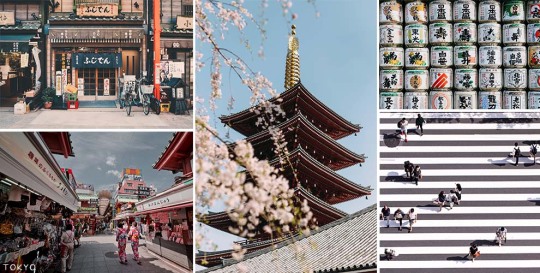
To get a feel for Tokyo’s many sides, go twin-centre and book a night or two at Hotel Gajoen Tokyo. Located in the hip Meguro district, from here you can seek out trendy shops and craft cafes. And, if you’re visiting in the spring, don’t miss the annual cherry-blossom festival as these iconic trees drop their confetti-like petals.
WHERE TO STAY
At times, Tokyo can feel a little overwhelming, so we highly recommend choosing hotels in a great location, but with a sense of space and calm. Tokyo Station Hotel puts the capital’s highlights at your feet, while Hotel Gajoen Tokyo feels like a city-centre retreat: tranquil, elegant, yet moments from the trend-setting Meguro district. Suggested stay 3-5 days.

ALL ABOARD THE SHINKANSEN
Catching the Shinkansen is an effortless experience. Trains leave from both Tokyo station and Shinagawa station with surprising regularity – and typical Japanese efficiency. The average delay is just 36 seconds. And shortly after boarding you’re off: rocketing along at up to 320 kilometres per hour. Order some refreshments and take in the views as you whiz past Mount Fuji.
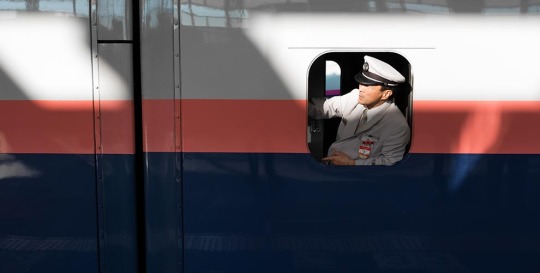
If time is tight, you could make the full journey to Kobe in two hours, 40 minutes. But we’d highly recommend making some detours along the way, starting with the spellbinding Izu.
THE NATURAL WONDERS OF IZU
Rugged coastline, mellow surfer beaches, dense forests dotted with traditional ryokan dwellings and onsen with their therapeutic hot waters. It’s hard to believe that the cool, green calm of Izu is under an hour away on the bullet train from the non-stop bustle of Tokyo. Known as the ‘province where the hot water gushes’, Izu is overflowing with natural wonders – take in views of Mount Fuji from the top of a volcanic crater, or wander through pink tunnels of Kawazu cherry blossom.
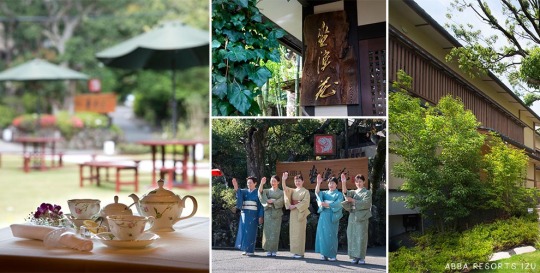
In perfect harmony with its unspoilt natural surroundings, ABBA Resorts Izu is a serene Japanese-inn style forest dwelling, where you’ll soon drift away into a state of Zen-like bliss in the mineral water bubbling up from the Ukiyama Hot Springs. Suggested stay 1-2 nights.
Take the Izuhakone Railway Sunzu line from Shuzenji Station to Mishima, then take the bullet train to Nagoya.
NAGOYA: THE BEST OF BOTH WORLDS
Nagoya’s location means you don’t have to travel far to experience awe-inspiring natural beauty. Head to the picturesque Japanese Alps for hiking and panoramic mountain views. Or stay in the city and visit the Shirotori Garden, full of flora and fauna all year round. Known for its special Hatcho miso, Nagoya is the perfect place to sample some of Japan’s most authentic flavours, from a hearty bowl of misonikomi to the tender meat of doteni.

Take the Kintetsu Express train from Kintetsu Nagoya to Kashikojima – a complimentary shuttle bus is available from Kashikohima to Shima Kanko Hotel: the Bay Suites in Ise-Shima.
A PLACE OF PILGRIMAGE: ISE-SHIMA
Princes, poets and pilgrims have long turned to Ise-Shima for spiritual, cultural (and culinary) inspiration. This ocean peninsula is where haiku-pioneer Matsuo Bashõ was born and where the Imperial Family is said to source their seafood. A stay in Ise-Shima demands a pilgrimage to Ise-jingū. This sacred Shintō shrine complex is the size of a small city – a labyrinth of inner sanctums, outer temples and moss-carpeted courtyards in a serene forest setting. The original shrines date from the 3rd century, but the ones you’ll see are newer – tradition dictates the shrines are recreated every 20 years to specific plans and ancient practices.
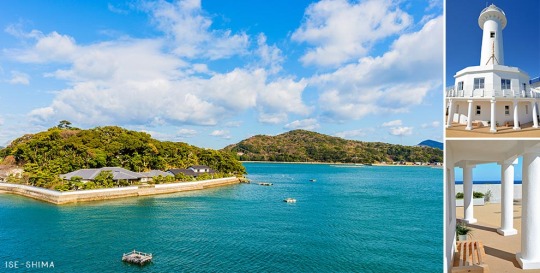
Breathe in the postcard-worthy peacefulness of Ise-Shima National Park from the comfort of Shima Kanko Hotel: the Bay Suites, an all-suite Japanese retreat on the shores of Ago-Wan Bay. Enjoy the perfect pairing of sunsets with your seafood at Michelin-starred La Mer, or get a taste of everything on the intricately prepared tasting menu at Hamayu, the hotel’s second restaurant. Immerse yourself in the local culture with Shima Kanko’s impressive array of activities, from making your own oceanic accessories at Pearl Miki, to taking part in a traditional Tea Ceremony in the beautiful Tatami Room, ‘Guan’. Suggested stay 2-3 nights.
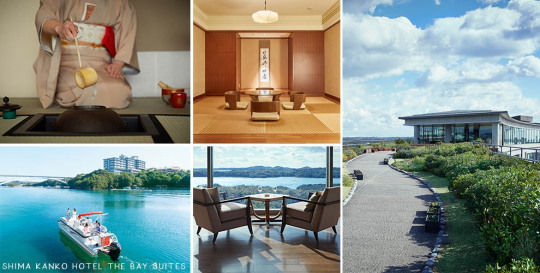
Take the Kintetsu Express train from Kashikojima to Yamatosaidaiji, transfer to the Kintetsu Nara Line to Kintetsunara (2h30m journey) – note that the Japanese Rail Pass is not valid on Kintetsu trains.
HISTORIC NARA
Next up is the first capital city of Japan, home to eight UNESCO World Heritage Sites. Wander through the serene Isui-en Garden, be inspired by the world-famous Todai-ji Temple, lose yourself in the pathways that surround the Kasuga-Taisha Shrine. Along the way, you’ll encounter the sacred deer that roam free across the city. To really soak up the atmosphere of Nara, we recommend staying overnight at Noboriojo Hotel Nara. This boutique hotel is right at the foot of the Kofuku-Ji temple and renowned for its exceptional service and French-influenced fine dining. Suggested stay 1-2 nights.
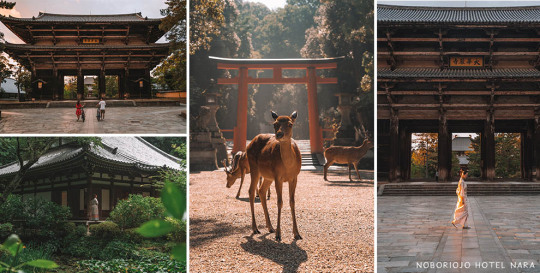
Miyakoji rapid trains operate every 30 minutes between JR Nara Station and Kyoto Station – the journey takes around 45 minutes. Kintetsu Nara and JR Nara Line also connect to Kyoto.
KYOTO: TEMPLES, TEA, AND PLUM TREES
With more than 1,000 temples and countless tea houses, Kyoto is the heart and soul of ancient Japan. And, while the best way to experience the city is to step out and lose yourself in it, there are some sights every traveller should see. Fushimi-Inari Taisha is an awe-inspiring shrine made up of hundreds of vermillion gates that form a tunnel up the mountainside. And, in the evening, the softly-lit Geisha district of Gion has an enchanting, secretive atmosphere. Make time for hanami, the ancient practice of flower-viewing, before sipping on sweet umami-plum tea fresh from the city’s groves, which come into full bloom every spring for the annual plum and cherry blossom festivals.
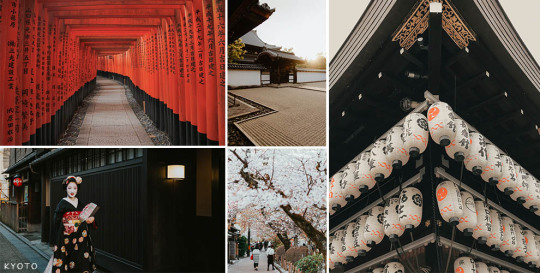
A restored ryokan with suites discreetly arranged among green courtyards, Sowaka perfectly complements this historic city. Harmoniously designed, traditional ryokan elements such as paper sliding doors are interwoven with modern comforts. Bath amenities are made with Japanese camelia oil, and the hotel’s water is drawn from its own underground spring. It’s all designed to create that Kyoto-state-of-mind. With the ancient capital on your doorstep, private tours are available to the nearby Kiyomizu-dera Temple – guided by one of the priests, you will have exclusive access to areas that are normally off-limits to the public. Suggested stay 2-3 nights.

Either take the Special Rapid train on the JR Kyoto Line which will get you to Sannomiya Station in Kobe in 50 minutes, or the high speed shinkansen to Shin-Kobe Station which only takes half an hour.
LAST BUT NOT LEAST: KOBE
Home to the highly prized Kobe beef, your final destination is an ancient maritime gateway with the verdant Rokko mountains as a backdrop and the sea stretching beyond the bustling port. Climb the Port Tower for great views of the city and then visit the numerous shops and restaurants along the waterfront, or Take a stroll along Harborland and Meriken Park. Compact and picturesque, most things can be reached on foot from your luxury hotel, Hotel La Suite Kobe Harborland. Overlooking the harbour with stunning sea views, every bedroom has a large Jacuzzi bath with a television for the ultimate relaxation time. Suggested stay 1-2 nights.
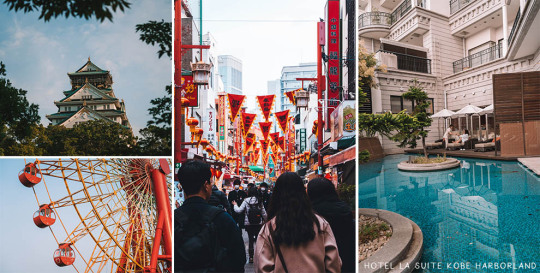
TRAVEL TIPS
Make sure you choose the correct category of Shinkansen for your journey. On the Tokaido Shinkansen, from Tokyo to Kobe, the most frequent and fastest option is the Nozomi. If you’d like to use the Japan Rail Pass, your best choice is the Hikari which takes just over three hours.
BOOK YOUR BOUTIQUE HOTELS
To book the hotels on this independent itinerary, get in touch with our Voice Reservation Team on 0800 0482 314 (UK) & 1-877-234-7033 (US). You can find a full list of our dedicated toll-free numbers here. We’re ready and waiting to plan luxury adventures 24 hours a day, seven days a week. So whenever inspiration strikes, just get in touch.
The post Fast trains and paper cranes: a Japanese adventure appeared first on Small Luxury Hotels.
from Small Luxury Hotels https://ift.tt/3c0PVxx Publish First on
0 notes
Text
A Luxury Travel Guide For First Time Visitors To Japan
From ancient, wonderfully serene temples to captivating, futuristic cities, Japan’s charms are irresistible. Come to experience its delicious food, unique culture, gracious hospitality, and striking natural landscapes covered in pink cherry blossoms (sakura), and you’ll be forever changed.

While this is by no means a complete travel guide, it's a good starting point for first-time visitors looking to sample the true essence of Japan:
Get a Taste of Modern Japan in Tokyo
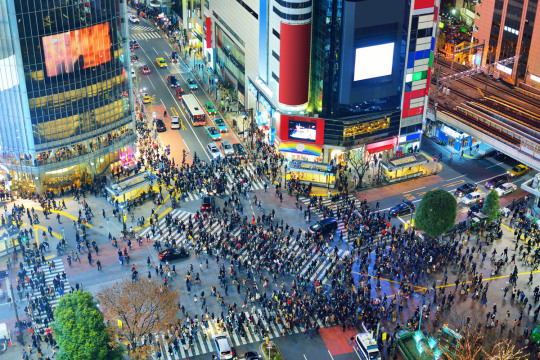
With futuristic skyscrapers standing side by side with ancient wooden houses, and quaint country lanes sharing space with broad and bustling neon boulevards, the world’s largest metropolis is an unforgettable experience.
Although rooted in its traditions, Tokyo is passionate about everything new, offering ultra-modern galleries, sophisticated hotels, classy lounges, and some of the best restaurants on the planet. From creative fashion to state-of-the-art gadgets, its fabulous shopping scene has something for everyone, while the astonishing culinary landscape is brimming with Michelin stars and exquisite sushi.
Feel the city’s pulse on its dizzying neon lit streets, find peace and quiet in its magical shrines and luscious gardens, or dive into the unique manga/anime culture in the district of Akihabara. For some luxurious retail therapy, head to Ginza, where swanky boutiques, glamorous department stores, and the crème de la crème of international designers fulfill every shopper's fantasy.
Take the Bullet Train to Ancient Kyoto
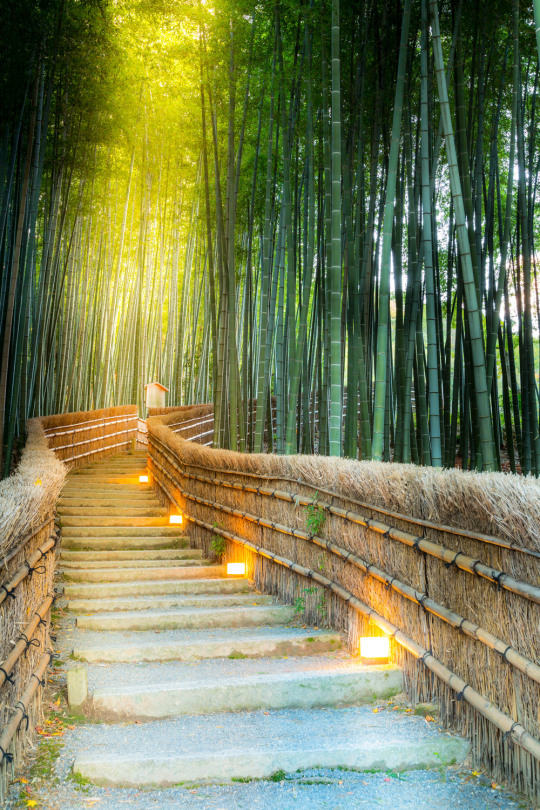
Steeped in culture and tradition, Kyoto is the best place to experience the true spirit of Japanese hospitality (omotenashi), whether in a century-old tearoom or a world-class ryokan.
A sense of history, elegance, and refinement prevails throughout the formal capital of Japan, and there are over 1,000 Buddhist temples to marvel at. Don’t miss the splendid Kinkaku-ji (Golden Pavilion), with its shimmering gold leaf coating and delightful Zen garden, or the famous Fushimi Inari-Taisha shrine, where over 5,000 bright orange torii gates make up one of the city’s most memorable sights.
After touring Kyoto’s outstanding attractions, take a break from sightseeing with a stroll through the magical Sagano Bamboo Forest in the Arashiyama district of western Kyoto, or wander through the atmospheric streets of Gion, the city’s entertainment and geisha quarter.
The shinkansen, Japan’s so called bullet train, is the fastest and most convenient way to travel between Tokyo and Kyoto.
Eat and Soak Up the Vibe in Osaka

The high-speed shinkansen train will get you from Kyoto Station to Shin-Osaka Station in 14 minutes. Once here, explore the city’s unrivaled food scene, mingle with the friendly locals, and just dance along to the unique rhythm of Japan’s third largest metropolis.
Nicknamed tenka no daidokoro (the nation's kitchen), free-spirited, fun-loving Osaka is brimming with great restaurants serving everything from fine French cuisine to some of the best traditional Japanese food. Dining options abound in Dotonbori, a bustling, neon-laden district near Namba Station; Shinsekai neighborhood is particularly noted for Kushikatsu (a type of skewered deep-fried street food); while Kitashinchi (Umeda) downtown is packed with wonderful sushi joints and ramen establishments.
Stroll down the elegant Midosuji Boulevard – lined with typical Gingko trees and exquisite shopping boutiques; visit the Open Air Museum of Old Japanese Farmhouses in Hattori Ryokuchi Park for a taste of Japanese rural life; or take a day trip to the cosmopolitan seaside city of Kobe (about 35 km west) to indulge in Japan’s world-famous beef.
Pray in Hiroshima

The bullet train journey from Osaka to Hiroshima takes just a little over 1 hour, which means you can easily include the picturesque port city in your Itinerary.
Although primarily known as the target of the first atomic bombing in human history, Hiroshima is now a symbol of world peace – a thriving modern metropolis with wide leafy boulevards, tranquil parks, interesting museums, and a blossoming food scene.
One of the city’s most remarkable sights is the sprawling, contemplative Hiroshima Peace Memorial Park, home to the UNESCO-protected A-Bomb Dome, an outstanding museum, as well as memorials dedicated to the victims of the bombing.
Otherwise, spend your time partying in Nagarekawa, visiting the fascinating Itsukushima shrine on the nearby Miyajima island, and tasting Hiroshima’s famous delicacies – oysters and okonomiyaki.
Don’t Miss the Cherry Blossom Season

The weather varies greatly throughout Japan, but spring and fall are, no doubt, the most pleasant times to visit the country. Every year, from March to May, people from all over the world come to the Land of the Rising Sun to experience the fabulous cherry blossom season, whereas in autumn (September to November) they come to witness the vibrant foliage in gardens and parks throughout the country.
Nevertheless, summer comes with colorful festivals (matsuri) and the winter is perfect for skiing and soaking in a mountain onsen, making Japan an excellent year-round destination.
167 notes
·
View notes
Photo







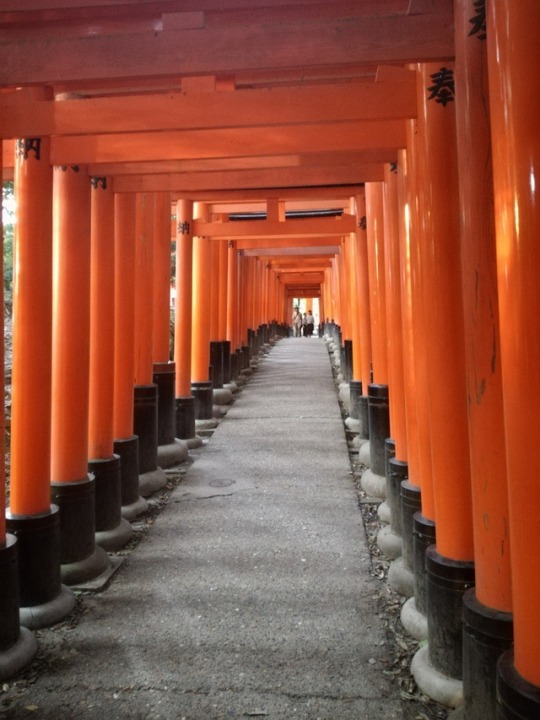
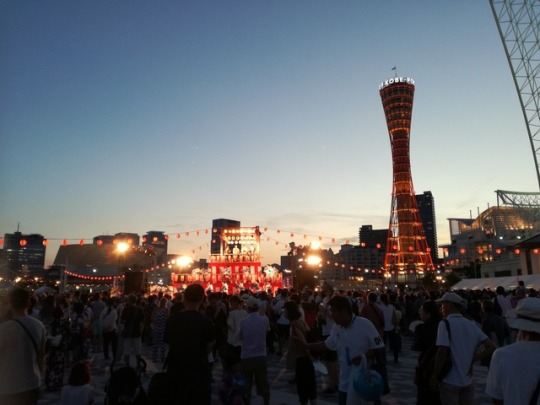
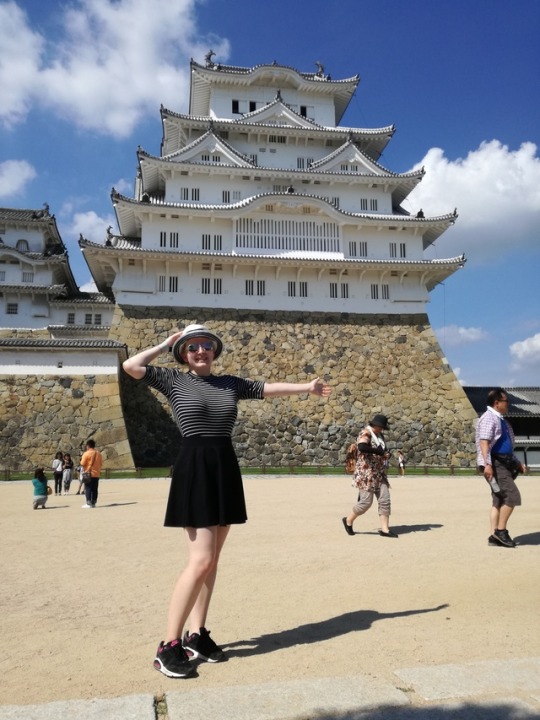
Our week in Kansai Area is now sadly over ;^; we had a cute hostel with tatami matt room (Santana Guest House) one station to Kyoto main station. In this week we visited: ・Kyôto: Yasaka shrine by night, Kinkaku-ji, Kamogawa, Gion district, Daimonji festival, Nijo castle by night ・Ôsaka: Universal Studios (HARRY POTTER!) ・Nara: Todai-ji and Nara Park ・Himeji: Himeji castle, city ・Kobe: Kobe port and kobe beef restaurant ・Yamazaki: Yamazaki distillery And last but not least: Fushimi Inari Shrine (famous and biggest fox shrine) Now one week is left in Japan and we are heading back to Tokyo 💕
20 notes
·
View notes
Photo
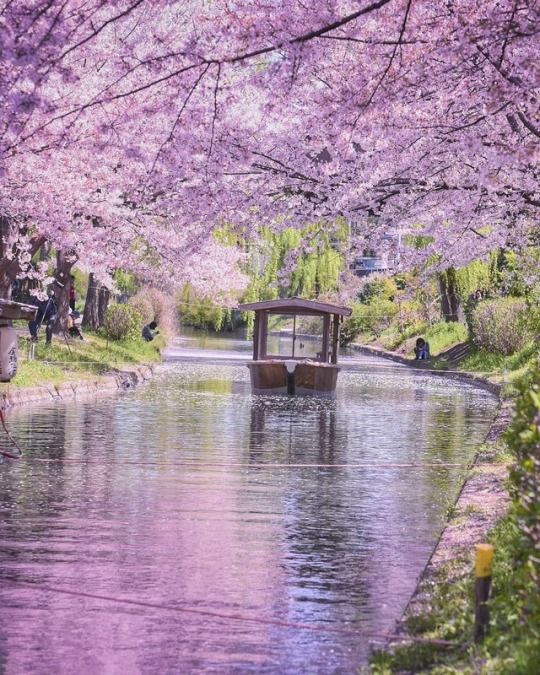
Fushimi Port Park, Kyoto, Japan via /r/MostBeautiful http://bit.ly/2WvlT0e
0 notes
Text
Trip To Japan Part 2
assalamu’alaikum
Well.. lanjut dari postingan sebelumnya ya.. Di part 2 ini aku mau cerita mulai dari ketemu sama temenku setelah keluar pintu kedatangan bagian selatan, sampai nanti pisah dan nginep di bandara malamnya karena pulang dengan penerbangan pagi jam 9.55 am Day 1. Begitu ketemu temenku, tempat yang langsung kami tuju adalah pusat informasi turis. Karena aku udah hitung-hitungan dari sebelum berangkat, aku putuskan untuk pakai Kansai Thru Pass (KTP) untuk 3 hari, tiket ini mengcover hampir seluruh moda transportasi di daerah kansai (osaka,kobe,nara,kyoto sampai himeji) kecuali JR. KTP bahkan bisa digunakan untuk transportasi bandara, jadi hemat. Ditambah lagi ada banyak kupon diskon, sayangnya gak aku gunain satupun, hehehe. Nanti aku sambil ceritain penggunaan di hari berikutnya. Selain KTP, aku juga berbekal ICOCA. Ini karena selama di Jepang aku harus naik bus dari shukugawa station menuju apato temenku, repotlah kalau pakai koin terus kan. Ditambah lagi kemungkinan aku akan ada naik kereta JR. Setelah beli persiapan untuk kartu pembayaran transportasi, kami sempatkan sholat dulu dan makan bento yang dibawain dia. Ada musholah di bandara kansai? Aku sih gak nemu ya.. jadi pilih tempat yang gak banyak orang lalu lalang, gelar alas shalat dan tentuin kiblat pakai kompas yang ada di apps. Sebenernya ada lounge gitu yang katanya bisa buat shalat, tapi tak tau juga. Kita gak cobain. Ada di lantai 2 kalau gak salah. Next, karena udah sore juga kan.. jadi kami memutuskan untuk balik aja dulu ke apato dan istirahat. Angin yang dingin menerpa wajah begitu keluar dari bandara melewati jembatan penghubung ke stasiun kereta. Saat itu sekitar 8°C, katanya sih itu belum dingin hahaha.
Dari bandara kita naik JR yang reserved langsung ke shin-osaka (pakai ICOCA karena JR gak tercover sama KTP dan mau dipakai besoknya aja supaya full day pemakaian) karena ini keretanya langsung jadinya kita dikenai biaya tambahan haha (ini salah naik kereta sih sebenernya, ada yg gak kena charge kok kalau mau, tapi harus beberapa kali transit) Sampai di shin-osaka kita naik JR lagi yang ke sakura shukugawa. Trus naik bus ke apato. Sepanjang jalan menuju apato mulai dari bandara, hal yang paling mudah aku amati adalah jumlah jalan disana lebih banyak daripada kendarannya. Jadi selama disana aku gak pernah lihat kemacetan. Sepi sih, orang-orang lebih pilih diam di dalam rumah kan karena musim dingin.

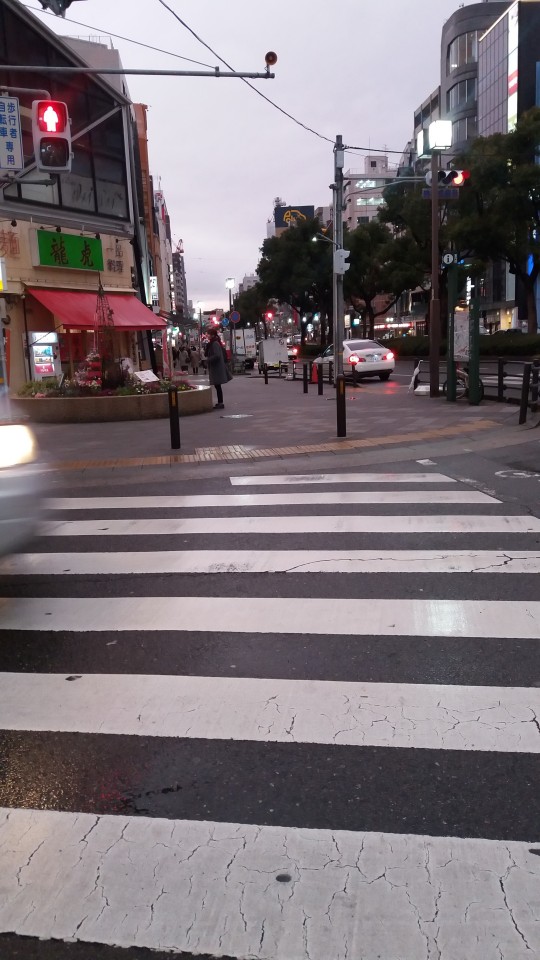
Day 2: to Nara Mulailah perjalanan. Pagi itu, begitu buka pintu apato langsung diterpa angin semilir yang dingin beud dan remah-remah salju pun turun.. yaaay (aku berharap saljunya banyak, tapi gak juga sampai hari terakhir) Sebelumnya aku kasih tips ootd. Kalau musim dingin, pilihlah pakaian yang bisa menahan dingin tapi tetap luwes bergerak, dan karena ini akan banyak melakukan perjalanan, pakailah sepatu yang nyaman. Dari apato kita menuju ke shukugawa station untuk naik kereta ke umeda station (kereta hankyu) di umeda kita ketemu sama temen yang dari malaysia, mereka sekeluarga. Dari umeda menuju ke namba (naik midosuji line) untuk transit naik kintetsu menuju nara. Sampai nara station tinggal jalan kaki ke nara park, lihat rusa jalan ke arah museum trus ada kuil gitu di seberang museumnya. Nara ini lebih bagus kalau dikunjungi di musim panas. Rumputnya hijau semua (kata temenku sih) atau peralihan musim semi ke musim panas jadi udaranya masih gak menyengat banget. Kalau musim dingin rumputnya kering jadi gak hijau, dan bulu rusanya gak bagus. Dari Nara Park, kita jalan menuju museum. Ada banyak museum disana. Masuk museum ini berbayar, di dalamnya ada benda-benda bersejarah dan ada ruangan yang menampilkan ritual kebudayaan gitu. Di depan museum ada kuil. Begitu masuk gapura kuil, kita akan menemukan pohon bunga sakura di kanan dan kiri. Saat itu sudah ada bakal bunga sakuranya, kalau sudah berubah warna pink pasti lebih bagus.. Ini aku seharian pakai KTP, tinggal di masukin di gate dan akan tercatat waktu pemakaian dan sisa hari. Bus ke apato aja yang pakai ICOCA
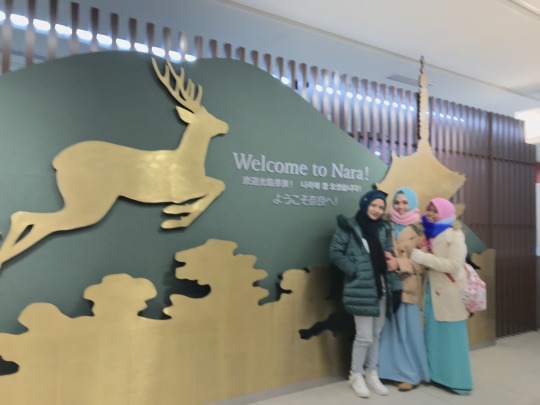
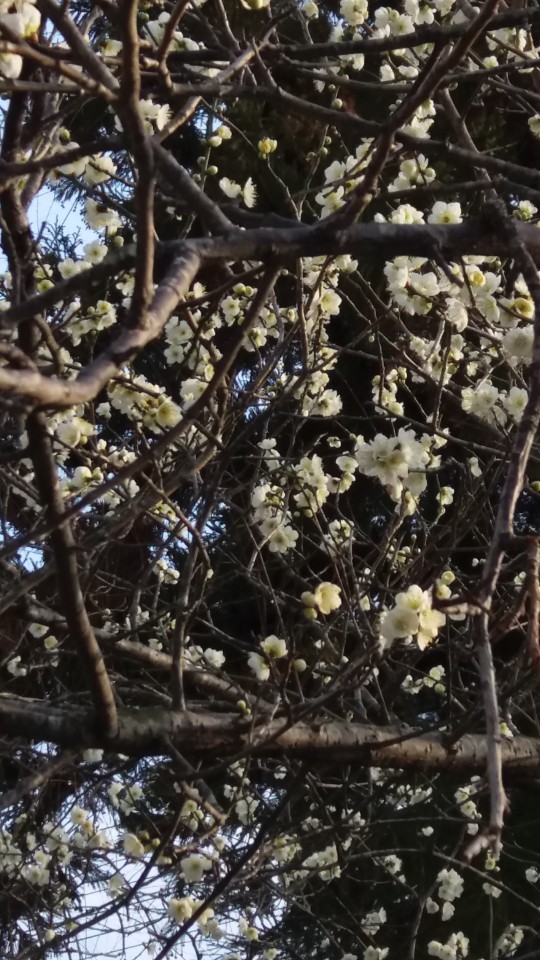


Day 3: to Kyoto Perjalanan ke kyoto terasa lebih seru sih kalau menurutku. Yang pertama kita kunjungi adalah arashiyama. Terkenal dengan hutan bambu-nya. Hari itu lumayan cerah walau tetap dingin, tapi gak sedingin di Nara kemarin. Hm.. disini ada acara pakai kimono. Tapi kan... karena males ribet-ribet, aku gak pakai kimono. Mau jalan jauh soalnya, dan aku tak bisa jalan pakai gituan hahaha. Oke fix, pas ditanya sama kakak yang dari malay "tak nyesal ke?" Tak lah.. Belajar dari perjalanan di Nara kemaren juga. Outfit yang nyaman itu sangat-sangat berpengaruh kepada seberapa asyik perjalananmu. Soalnya pas di Nara aku pakai boot yang masih terbilang baru dibeliin temenku (baik banget kan dia, aku nya yang jadi gak enak) sakit ujung jarinya. Jadi pas di kyoto gak lagi-lagi deh demi outfit gituan. Tadinya aku kira bisa sewa bentar doang buat foto, ternyata gak bisa. Ya kan sayang aja kalau udah sewa untuk 2 jam, dipakai bentar doang untuk foto. Setelah foto-foto di arashiyama dan gak lupa beli oleh-oleh, kita beranjak ke gion. Awalnya mau ke kinkakuji dulu malah mau ke fushimi inary juga. Tapi karena keburu sore, kita langsung ke gion biar gak kemalaman pulangnya. Soalnya anggota perjalanan salah satunya adalah baby hehehe. Walaupun si baby kuat amat melawan dinginnya udara waktu itu. Di gion ada spot foto gitu semacam kuil, aku lupa namanya. Terus lanjut kita jalan menuju naritaya ramen halal. Aseli ini keliling-keliling nyarinya tapi seru sih, jadi banyak yang bisa dilihat. Gak cuma warung ramen halal disampingnya ada resto daging halal. Dan ternyataaa salah satu pegawainya adalah orang Indonesia yang lagi belajar bahasa disana. Selesai makan, langsung memutuskan untuk pulang. Selama di Kyoto, kita gunain KTP untuk kendaraan dan ini mengcover semua mulai dari kereta sampai bus. Mau naik bus berapa kali pun tinggal tunjukin aja KTP (kansai thru pass ya.. bukan kartu tanda penduduk) milikmu, dan driver akan mempersilakan jalan.
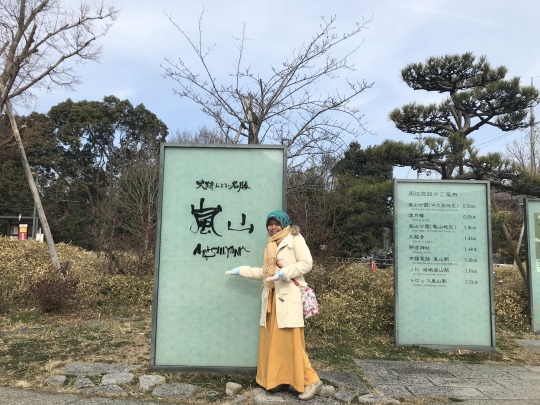
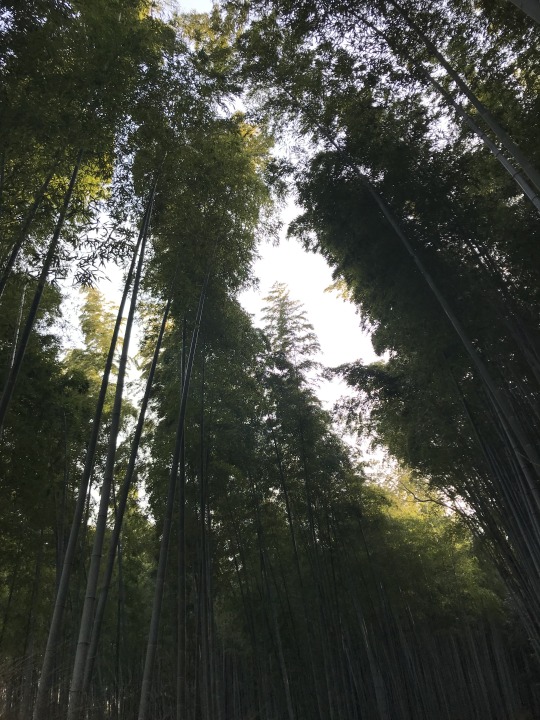
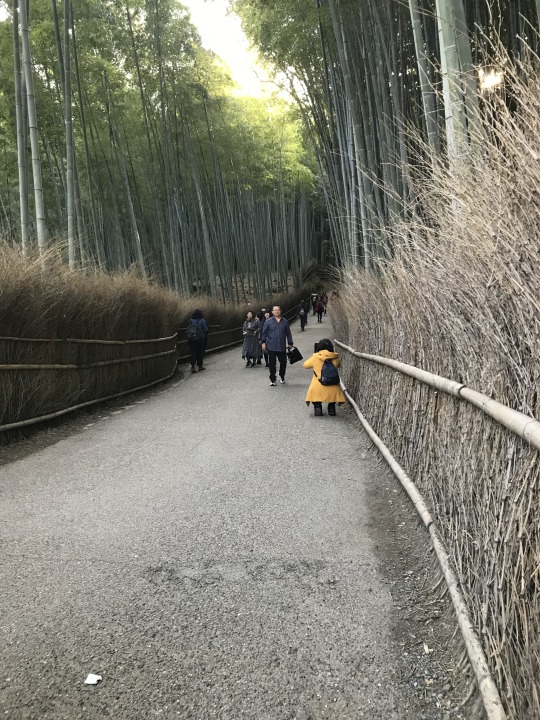
lupa fotoin tokonya, jadi ini screen capture dari hasil pencarian di maps
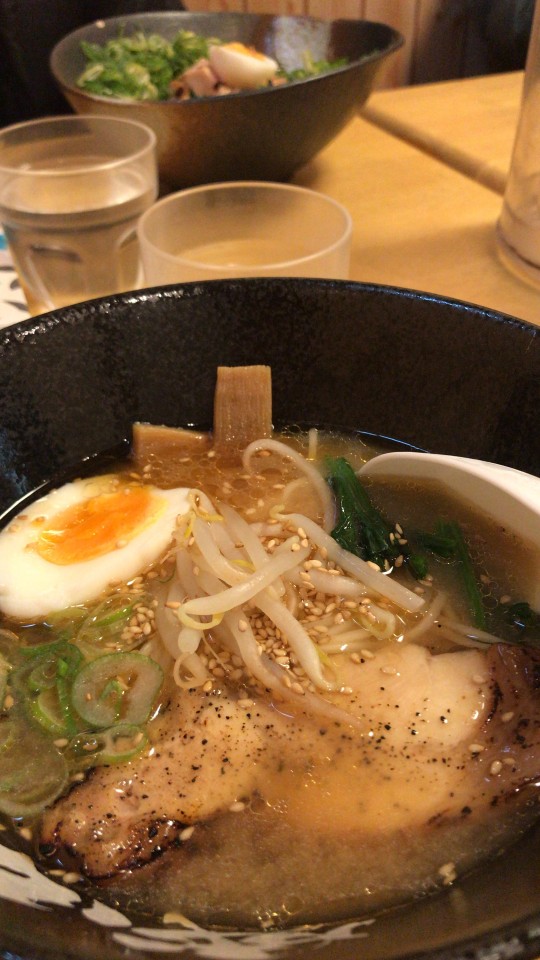
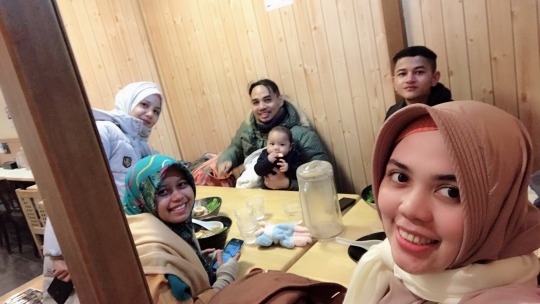
Day 4: to Kobe Pagi hari dibuka dengan hujan. Tadinya aku pikir turun salju, ternyata hujan. Cukup berkabut sih. Hari ke-4 ke kobe kita udah rencanain mau ke rokko mountain buat main salju, huhuhu cuaca tak mendukung sebenernya. Tapi tetap pergi. Hari ini gak pakai KTP, aku pakai ICOCA aja. Jadi sampai juso station kita beli paket tour ke rokko mountain, yang sudah mengcover biaya kereta dari stasiun asal sampai ke stasiun rokko dan sebaliknya. Juga biaya bus dari rokko station ke cable way menuju puncak gunung rokko, dari station cable way menuju ke rokko park dan sebaliknya. Juga tiket masuk rokko park plus musical box museum. Cuacanya masih tetap mendung, gerimis-gerimis manja. Sempat cerah sebentar. Tapi terobati setelah lihat hasil fotonya, kita serasa lagi melawan badai salju (eaaaaa) Di rokko mountain ada resto juga, mereka sedia menu halal. Walau ada banyak menu yang tertulis no pork no alcohol, tapi tetaplah pilih menu halalnya. Karena sudah bersertifikat halal dari serikat muslim disana. Dan ada prayer room juga di sisi kiri sebelum pintu masuk rokko park. Dari rokko, kita menuju ke....masjid kobe, alhamdulillah di negara dengan minoritas muslim, masih ada masjid yang sangat layak untuk digunakan. Ada 3 lantai. Tapi umum digunakan 2. Lantai 1 untuk laki-laki. Lantai 2 untuk perempuan. Next, kita menuju kobe port, lihat laut dan menara kobe. Selesai hari keempat. Dan kita memutuskan untuk kembali. Oiyaa ada yang hampir terlupa, di juso station sebelum berangkat ke station rokko, kami bertemu oma2 jepang tapi bisa bahasa Indonesia dengan jelas. Beliau sempat tinggal di Bogor.wahaha kerenlah

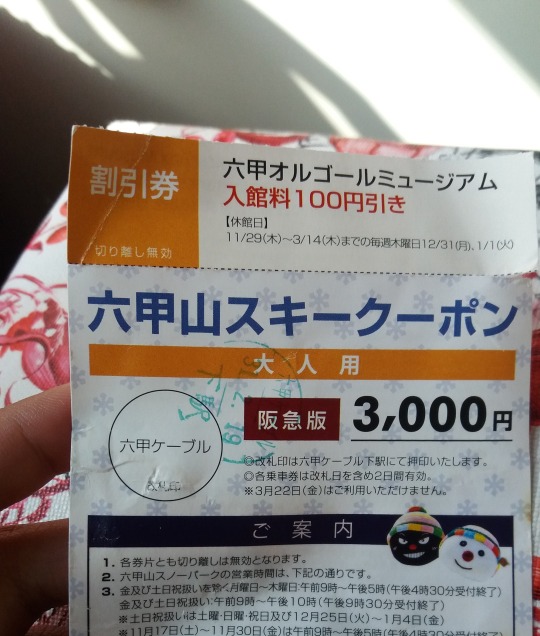




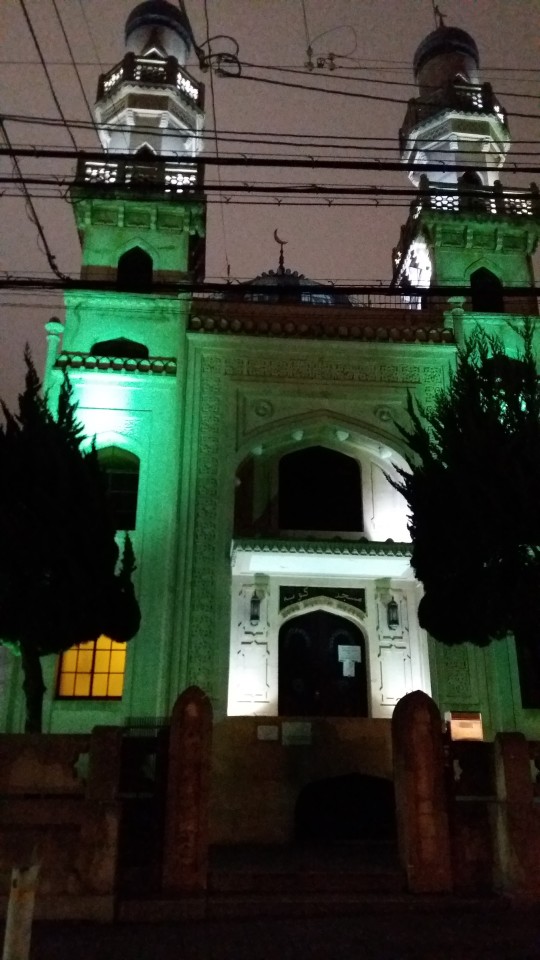
Day 5: Osaka Belajar dari kejadian di kobe yang sepanjang siang hujan, aku pun periksa cuaca hari itu. Memastikan cerah... dan ternyata laporan di babang google bilang hari itu cerah, siang bisa sampai 13°C, seneng dong ya.. membayangkan hari itu gak bakal sedingin hatimu, eh.. sedingin kemarin maksudnya. Ouu ouu ouuu, ternyataaaa... suhu memanglah sekitaran 11-12° tapi anginnya banyak sangat, dan tetaplah dingin... untunglah tetap pakai coat tebal. Spot pertama yang didatangi adalah USJ, gak masuk ini cuma keliaran di luarnya aja buat foto. Next ke osaka castle. Disini ada bakal sakura juga looh... kalau datang di musim semi baru bagus banget. di osakajokoen hall nya lagi ada konser waktu itu, g tau sih ya konser apaan, kayaknya boyband karena beberapa cewek-cewek remaja pakai atribut fans gitu.. (gak terlalu suka lihat boyband juga, jadi gak tertarik) Next, dari osaka castle menuju ke dotonbory. Oiya... dari osaka castle ini, kami memilih naik kereta dari OBP station menuju namba. Dari namba station jalan kaki ke dotonbory, beli oleh-oleh (ini lama banget... ntar aku jelasin di bawah ya apa yang buat lama) Dari semua tempat dotonbory ini aja sih yang buat aku ngerasa suasananya beda. Gak sebersih tempat lain,Dan rameee banget. Mungkin turis yang kesana harus lebih aware sama sampah masing-masing -_- Selesai foto, belanja, dan menikmati semilir angin yang tak begitu dingin karena rame sangat, kami pun memutuskan untuk pulang. Nah... di perjalanan pulang, aku ingatkan.. perhatikan jadwal kendaraan yang akan kalian naiki, terutama bus. Apalagi kalau bus nya terbatas. Malam itu, karena penat jalan jadi aku sama temenku memutuskan untuk naik kereta selanjutnya aja biar bisa duduk. Alhasil kita ketinggalan bus, dan harus nunggu 40 menitan untuk bus selanjutnya dan itu bus terakhir.. huaaaa. Sampai apato jam 12-an. Di osaka seharian pakao ICOCA
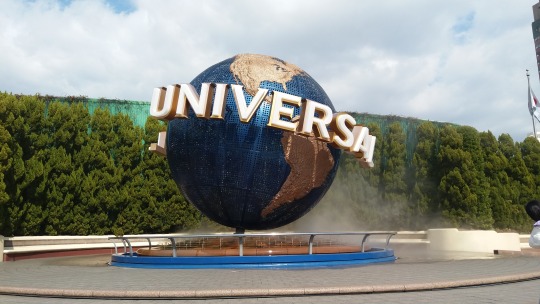

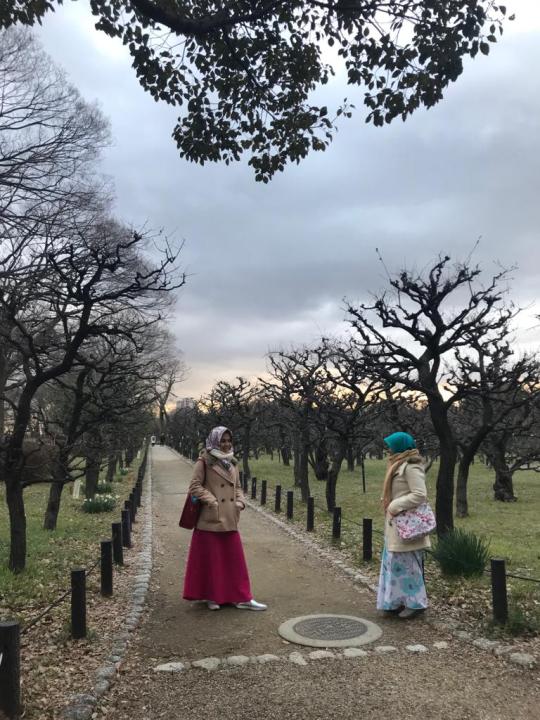


Day 6: Osaka and kix Hari keenam jadi hari terakhir ngerasain masakan dia di apatonya kerana malam hari kami memutuskan untuk nginap di bandara supaya gak ketinggalan pesawat. Sebelum ke bandara, disempetin dulu ke umeda sky building. Karena dari apato udah bawa koper jadi di umeda station kita sewa loker gitu. Cuma foto doang sih ini trus balik ambil barang-barang menuju ke bandara kansai. Sebelum ambil barang-barang di loker, sempat nonton pertunjukan dulu di umeda station. Sejenis pertunjukan budaya jepang gitu, ada yang menari pakai kimono, terus modern dance dengan pakaian ala jepang tapi udah dimodif ditambah lagi atraksi ninja. Selesai.. next menuju bandara kansai.... Karena pakai KTP, maka aku sama temenku memilih kereta yang tercover KTP. Rutenya. Dari umeda ke namba (midosuji line) namba ke bandara (ada yang lansung tapi harus beli tiket, jadi kita memutuskan untuk naik yang di jalur 5 ke arah wakayamashi station dan akan transit di izumisano station) pas naik, ada mba-mba jepang nanya mau ke bandara ya? Yes, aku jawab kan. Terus dia bilang lagi, ini gak sampai kansai airport, dan aku jawab iya.. nanti aku bakalan transit. Dan dia pun ngangguk2 paham. Jan lupa bilang makasih (thank you or arigatou) ya.. Dari izumisano langsung naik yang kearah bandara dan alhamdulillah tiba dengan selamat. Malam itu nginep di bandara, tidur seadanya di kursi hehe karena rombongan jadi gak terlalu khawatir. InsyaAllah aman. Di bandara juga aku sempat main vending machine yang dapat bola isinya mainan gitu (bocah banget sih ya.. tapi suka) Di bandara ada gift shop, kalau gak sempat beli di tempat wisata. Harganya relatif sama aja tuh. Aku sempat beli beberapa karena ada oleh2 yang kelupaan


Day 7: Back to Jakarta Kalau ini mah pulang cenderung lebih aman kan mau masuk ke negara sendiri. Masuk, ngelewati meja yang meriksa struk belanjaan free tax, jadi ntar itu struk belanjaan diambil sama mereka. Gak ditanya-tanya kok. Langsung menuju imigrasi, kasiin paspor dan tiket. Di stamp sama petugasnya meniggalkan jepang tanggal xx xx xxxx. Ngelewatin mesin x ray, next masuk ke ruang tunggu. Nunggu pesawat, dan tepat waktu.. Perjalanan 4 jam ke manila. Transit (prosesnya sama seperti berangkat, singgah di transfer desk dulu) dan penjalanan 4 jam ke soetta. Sampai deh di negara tercinta yang hangat ini.. Alhamdulillah... Oke, di bawah aku akan jelasin beberapa point yang belun dijelasin di atas. Makanan Hm.. selama disana aku seringan bawa bento sih ya demi menjamin kehalalanya. Sempat beli makan di resto waktu di kyoto ada ramen naritaya, resto beef naritaya juga. Di kobe ada di resto rokko park yang nyediain 2 menu halal. Di sekitaran masjid kobe juga ada minimarket halal. Tips dari temanku, bisa beli onigiri dan lihat komposisinya. Lebih aman beli yang isinya tuna atau salmon. Walau ayam atau sapi, kalau tidak ada jaminan halal, jangan dimakan.. mereka bisa jadi sembelihnya gak pakai bismillah. Pray room Selama disana tempat yang didatangin dan ada pray room nya cuma di rokko park, dan satunya di masjid kobe tentunya :D. Lah... terus selama disana shalatnya dimana dong? Ada kok sudut-sudut yang bisa digunakan untuk shalat. Jarang dilalui orang-orang. Dan kami kemana-mana selalu bawa alas shalat, semacam tikar lipat gitu, tapi gak gede banget. Ukuran personal lah.. Kemanapun kita, shalat itu wajib. Jangan gara-gara liburan, kita jadi tak ibadah. Kita liburan rezeki dari Allah, maka berterima kasih lah... jangan sampai kita dapat istidraj. Sedih betul kalau sampai kejadian. Oleh-oleh Selain souvenir (milih souvenir sih cenderung gak masalah karena bahan yang dipakai kayu, besi, plastik, gitu kan) jadi gak haram. Nah, yang tadi di atas aku bilang lama waktu kita belanja oleh-oleh makanan. Di beberapa blog udah ada kok tips memilih makanan yang aman. Tidak mengandung unsur hewani, sake, gelatin dan zat haram lainnya. Untungnya punya teman yang udah 3 tahun belajar bahasa jepang kan, jadi dia bisa langsung baca itu tulisan apaan. Ditambah lagi ada bantuan google translate hehe, tinggal foto aja tulisannya langsung ketauan komposisinya. Beberapa produk memang pakai komposisi tumbuh-tumbuhan, kalau lemak pun ambilnya dari susu kedelai (alasannya karena ada aja orang yang alergi lemak hewani, gitu sih katanya) Manner Dimanapun tetap jaga manner-mu. Alhamdulillah aku gak terlalu kaget dengan kondisi disana. Selain sering diberitakan, menyesuaikan diri untuk hal-hal umum seperti antri, permission dll juga udah sering dilakukan. Beneran, disana kalau naik eskalator sisi kirinya dibiarin kosong untuk orang yang mau jalan buru-buru. Masuk ke kereta juga antri, masuk bus juga antri. Kalau mau burur-buru dan ambil jalan orang lain boleh ucap sumimasen, excuse me, sorry, dll. Dan jangan lupa mengucapkan terima kasih setelah mendapatkan bantuan dari orang lain, walau sekecil apapun. Temenku juga kasih tips, kalau di tempat umum, walau kita lihat anak kecil jalan mau jatuh mendingan dibiarin aja (kan belum jatuh hehe) karena beberapa orang tua gak suka anaknya dipegang sama orang lain. Intinya disana rame orang, tapi warganga gak grasak grusuk.Tidak buang sampah sembarangan. Saat di kobe ini yang pengalaman banget. Mulai dari dari masjid kobe kita jalan ke port kobe (jauh ya kan.. haha, tapi karena rame jadi tak terasa penat) sambil bawa kantongan sampah bekas makan mie cup boleh beli dari minimarket halal dekat masjid. Apa gak nemu tempat sampah? Ya nemu.. tapi itu tempat sampah orang lain bukan yang umum disediain. Sampai akhirnya kita nemu tong sampah di dekat stasiun kereta (hehehe) Untuk orang yang mau mempelajari Islam dengan baik, pasti hal-hal ini gak asing. Aku perhatiin temenku selama disana makin rajin ibadahnya. Dan mereka yang disana pun sangat menghargai kita yang beragama. Selama kita menghargai agama kita. Sewaktu di kyoto juga jumpa ibu-ibu yang bilang kalau jilbab yang kami pakai cantik.. Kalau bawa jilbab cadangan, mau deh aku kasiin itu ibu hehehe. Teman-teman yang pernah tinggal di luar negeri dimana muslim adalah minoritas, memang kerap berkomentar. Saat menjadi minoritas, saat itulah kita diuji ada yang akhirnya sadar betapa berharganya Islam (tabarakallah) tapi, ada pula yang lalai dan akhirnya menutupi identitas keislamannya (naudzubillah) Dana yang dihabiskan Ini garis besarnya aja ya genks selama disana, soalnya kan biaya tiket sama visa mungkin bisa beda. 1. Transport Kansai Thru Pass (3 days): 5200¥ ICOCA : isi 5000¥ 2. Makan Ramen halal : 760¥-1500 ¥ Curry di resto rokko park: 1000¥ Onigiri +/_ 130¥ (tapi aku gak beli) 3. Tempat rekreasi Museum di Nara Park : 410¥ Tiket terusan rokko: 3000¥ 4. Oleh-oleh Kalau camilan kering dan permen ada banyak di minimarket sejenis Daiso harganya 100¥ all item Souvenir: up 300¥ kalau mau yang ada khas2 jepun nya gitu. Total selama disana aku habiskan 27.500 ¥ (masih ada kembalian) Kok bisaaa 7 hari loh (walau gak full) ?? Jawab: ya bisa lahh.. kan nginep di apato teman, jadi gak perlu bayar hotel, servicenya dll. Makan juga masak bareng :D Kalau mau bareng hotelnya yang sempat aku booking itu harganya sekitar 11.000¥ (pakai kembalian) Demikian cerita berkeliling sekejap di negeri sakura. Bagiku, Indonesia masih jadi yang tercinta :)
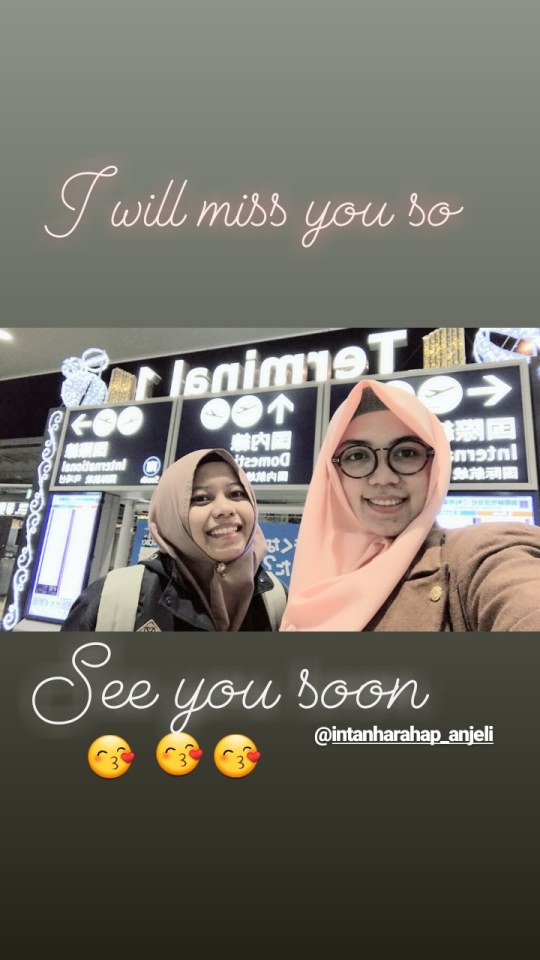
. Wassalamu'alaikum
27 Februari 2019 Indonesia Raya
1 note
·
View note
Text
A Trip of a Life Time
It has always been a life long dream of mine to visit Japan. This year, that finally happened. From March 23-April 2nd, I had made my way to and through Japan.
So I would like to walk you through my trip and what happened!
On March 23rd 2017, we left our house around 2:15am to arrive at the air port around 3am. The weather was terrible, we were having snow and ice at the time. Our travelling companion arrived around 3:45 am. We checked his bag, and headed through security around 4am.
Funnily enough, my great aunt was travelling on the same plane as us to Toronto, and we met up for a few minutes before boarding the plane.
We boarded our flight around 6:10am (on time!) for our departure at 6:50am. We were all seated and getting ready to go. Waiting to get de-iced, the maintenance folk thought they saw a leak. This caused a delay of over 2 hours, and we left after 9am when they determined it was just melting snow. During this delay, my spouse and I watched Doctor Strange in its entirety. Finally de-iced, we took flight.
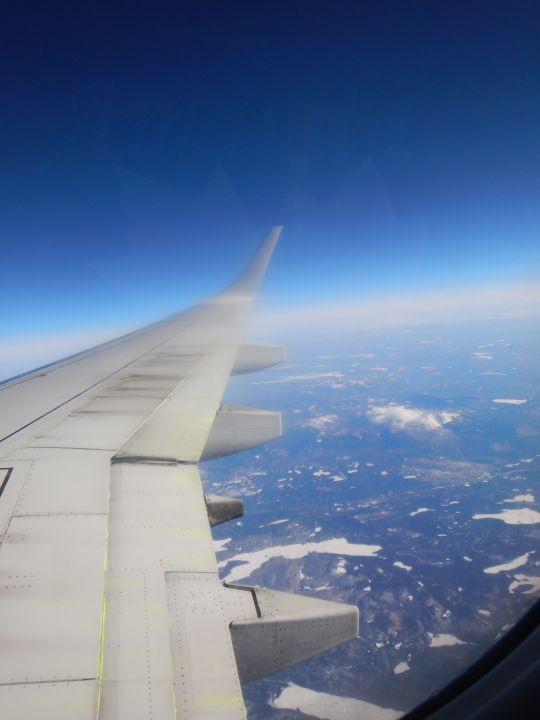
We arrived in the Toronto Pearson Airport around 10am EST (2hours after our flight left Halifax). Many of those on our flight had missed connections and there was a lot of chaos from the delay. Thankfully, it just made our layover shorter.
We were supposed to meet up with my great aunt and her friend for food, however, they were told they had a chance to make their layover and tried to get there. However, once all was done they sadly missed it and couldn’t get out of their section of the airport.
So we ate Pad Thai at Thai Express, and then made our way through security again, and to our terminal. It was pretty uneventful after this, and we boarded our flight to Japan at 1:50pm. Since our flight boarded quickly, we ended up leaving a little bit early at 2:20pm.
During the flight (which was 13 hours), I tried to sleep and watched movies. After awhile, you do get very uncomfortable, but don’t want to move and disturb those around you.I was excited, as the plane had Your Name which I had been wanting to see but hadn’t come out in North America yet. I also watched some episodes of the Big Bang Theory with my spouse. I don’t remember exactly what I ate on this flight, but I do remember really enjoying the chicken meal I had, and of course the best part of my flight was my Cup Noodle! I also watched most of Moana but fell asleep towards the end.
Since my spouse and I only took carry on bags, our moving through the airport and security was very fast and we were ready to go immediately. However, our friend had brought a checked in bag, which caused us a lot of delays with leaving. At the airport, we obtained our pocket wifi from Wifi Ninja and our Suica cards for the train.
We boarded to Monorail, and we were listening for our stop. A kind older Japanese man boarded the train and spent some time talking to us. It was really pleasant experience. We did, however, miss our train stop and had to get off and get back on the train on the other side.
We took in what we could as we boarded our next train towards our apartment we were renting. Once we found our way, we dropped off our goodies and went out to see what we could find.
We grabbed some drinks out of the vending machine, and headed to Lawsons and 7-Eleven to see what we could find. We then headed back to the apartment for the night.
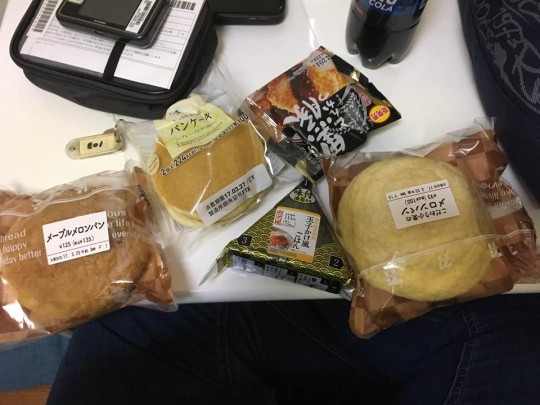
For our second day, we got an early start and headed out. We stopped at McDonalds and decided to try a Mega Muffin (two sausages, cheese, egg, and bacon) which was a delicious greasy mistake.
We walked around Akihabara and Shinjuku. Sadly, we didn’t realize most things didn’t open until later. So we didn’t do too much during this time.
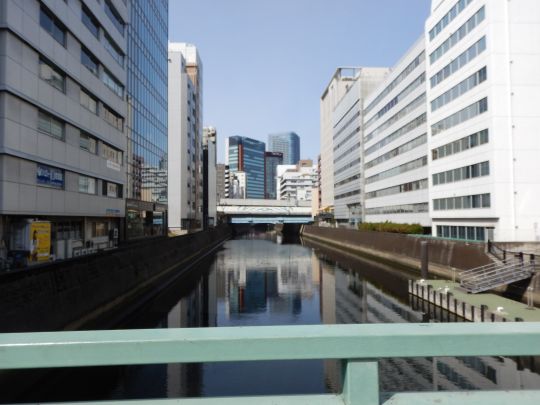

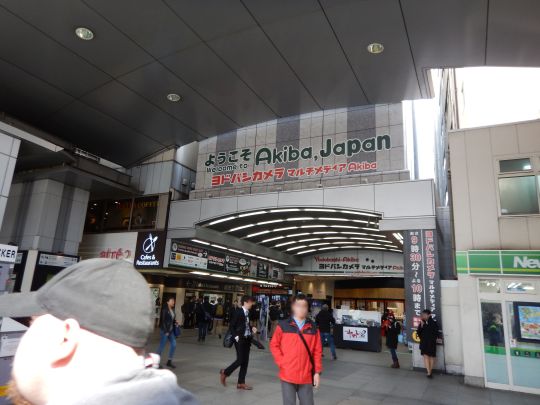
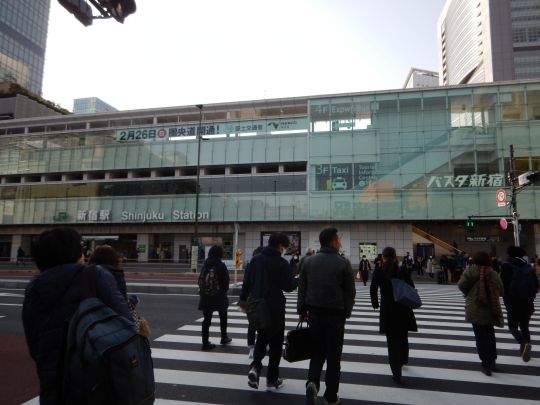
We found our way to pick up our Japan Rail Passes while were out though!
We found tons of vending machines while we were out.

And we found a Square Enix Cafe! Sadly you can’t see how long the line was, but it was definitely a few blocks long.
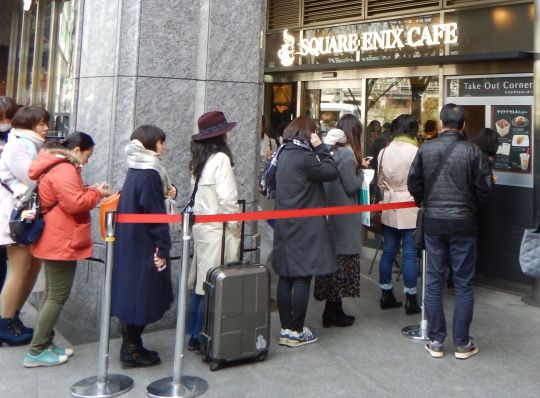
We later made our way over to Ueno Park and Zoo. Where we saw a lot of animals and cherry blossoms starting to bloom.


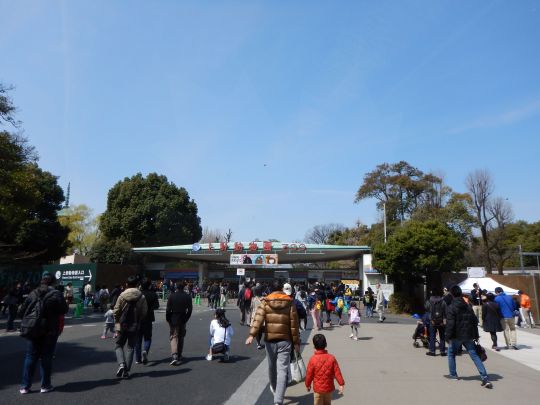
We also got to see some great signs!
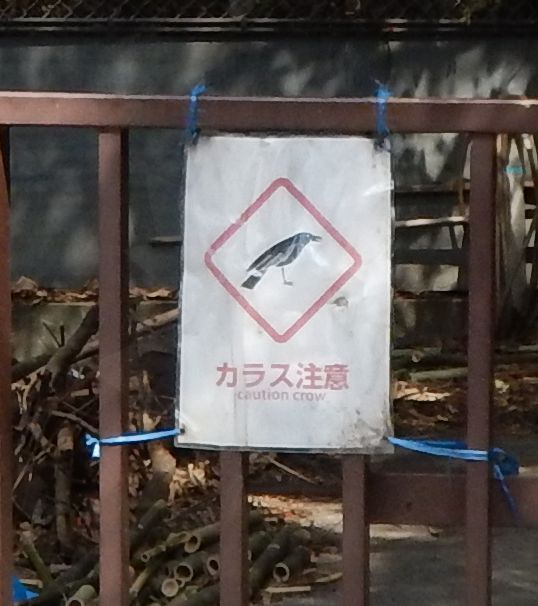
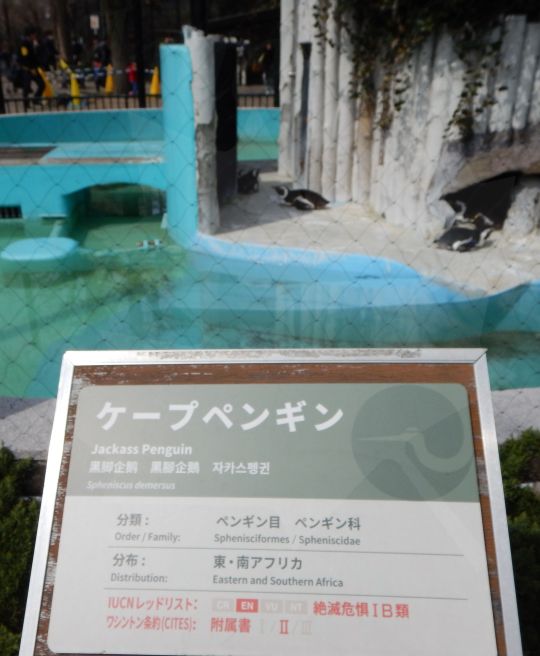
After this, I was exhausted and we headed home. I slept a long time this night!
The next day, we were just wondering around and taking in the sights. We checked out Taito Games and the Mega Tokyo Pokemon Center. I also tried some various foods, but notably it was some store bought dango!
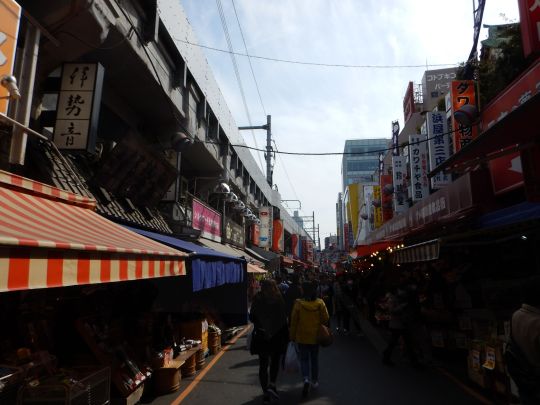

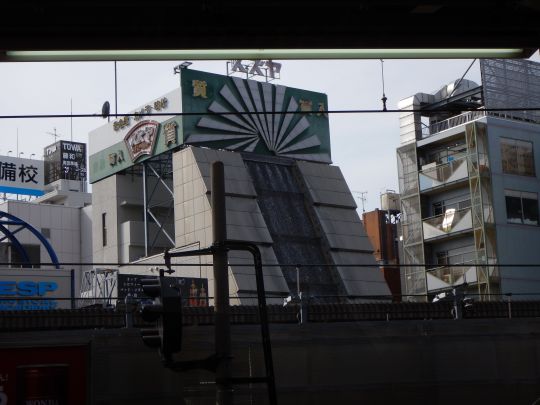
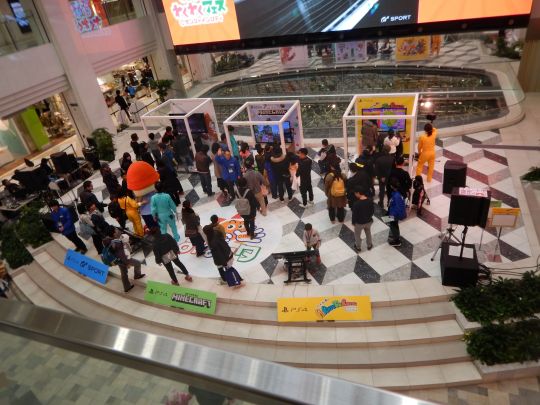
Because of being so sore, we didn’t do too much else this day. However, we did eat at McDonald’s again and had a Big Mac! It was the most beautiful Big Mac I have ever had.
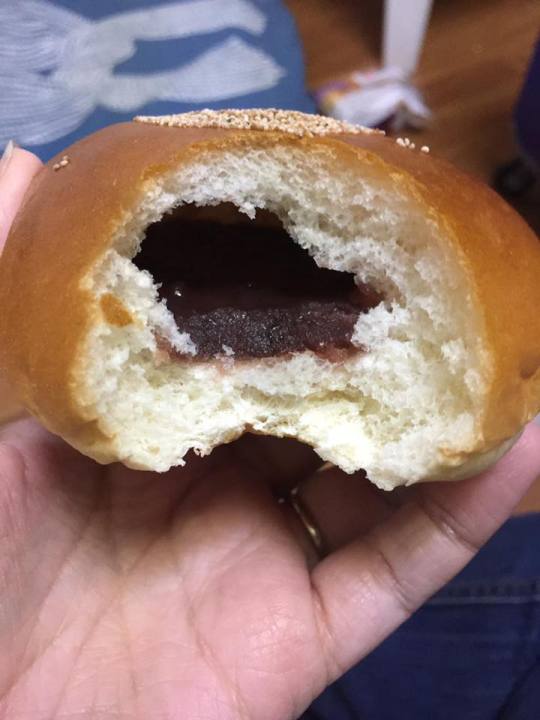
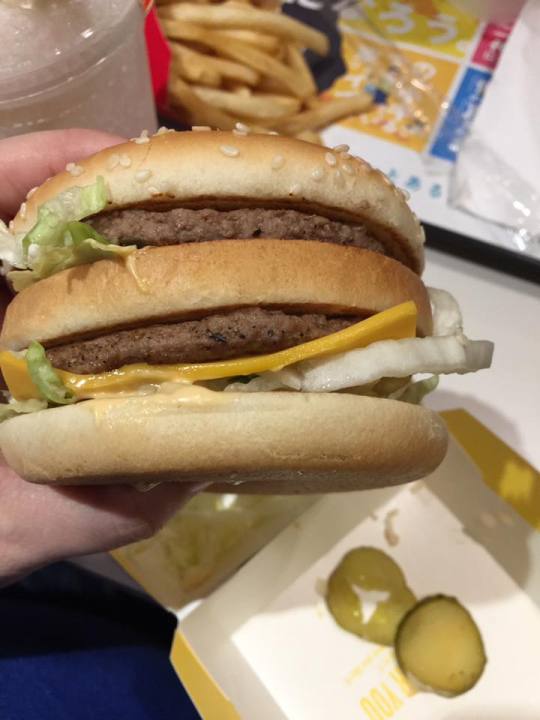
That brings us to the 27th. This was Disney Day! We visited Tokyo Disneyland which was way more emotional than I thought it would be. I was stunned when I got there. I hadn’t ever been big into going to Disneyland or World, but since it was near us I wanted to go.
I’m not one to be super corny, but it definitely felt magical. It also helped that it always smelled like candy in the park.
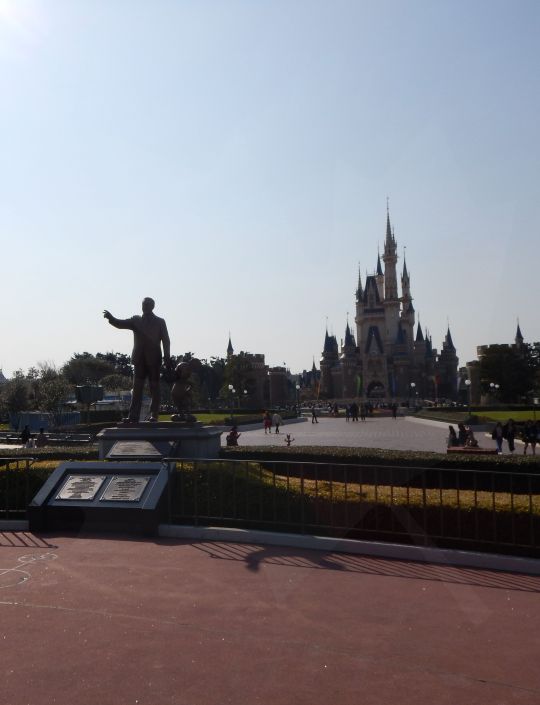
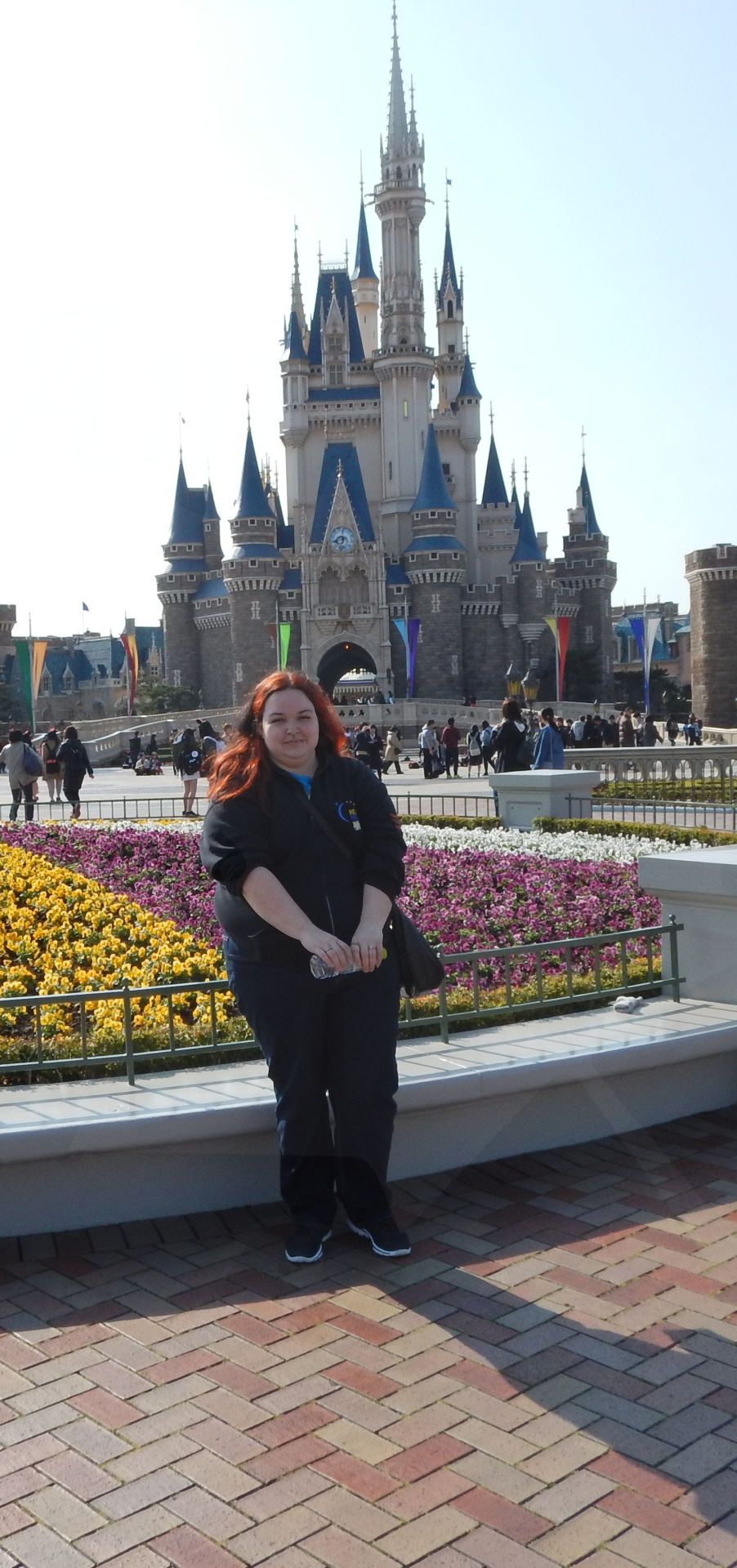
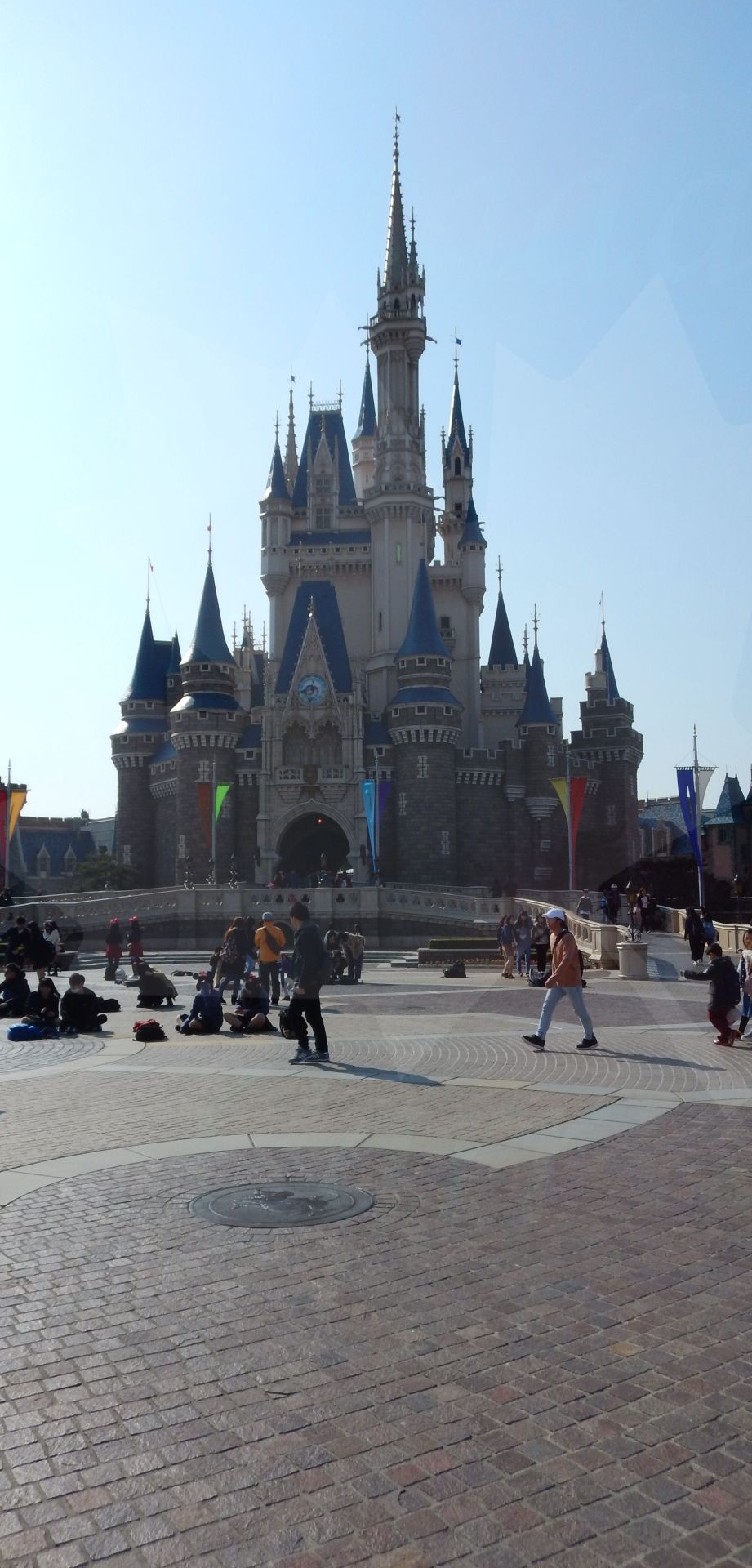
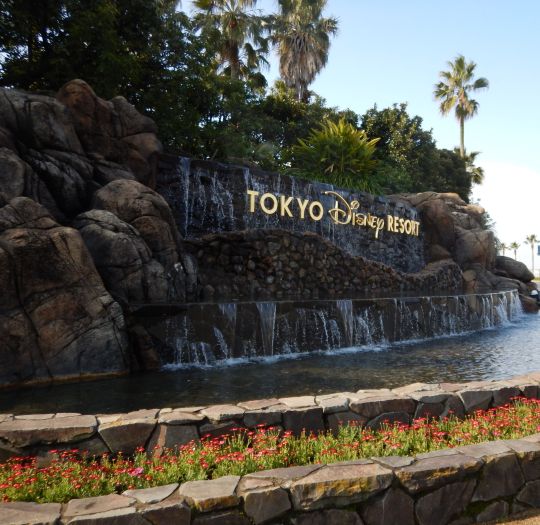
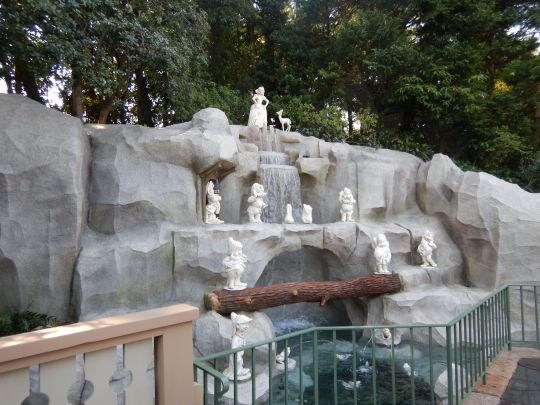
Once we left Disneyland, there was a crepe shop outside called Bell’s Crepes... and I knew I had to try one! I even ordered in Japanese!
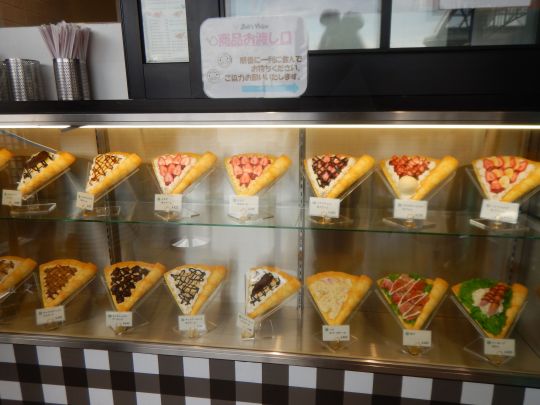

While we were in Tokyo, I got to meet up with one of the lovely girls I met when she was here in Halifax studying English. She took us to a great restaurant and we had a really good time! I can’t wait until I can see her next. :)
Then it was time to move on. We made our way to Kyoto to meet up with my close friend Yuuka, who I met while she was studying in Halifax. We visited the Fushimi Inari-Taisha shrine, which was beautiful. Those gorgeous torii will stick with me forever.
We ate at some of the vendors outside. We tried a mochi skewer, yakiniku and nikumaki! I think Nikumaki was my favorite. I ate it so fast I forgot to take a picture.



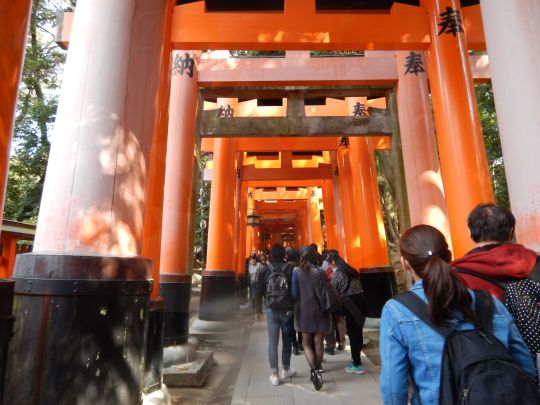
After this, we headed back to Osaka and ate at the restaurant Kappa Zushi.
We then headed to our capsule hotel in Dotonbori. The capsule hotel was beautiful, and outside of a bit of a language barrier, we got checked in and stayed the night.
My friend was busy the next day, so we made our way around to see what we could find. We visited an internet cafe, which was an amazing experience! I wish we had them here. It had a vending machine for hot food, and machine that dispensed free drinks for patrons!
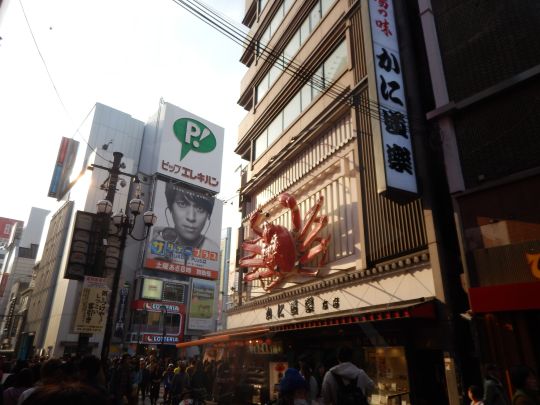
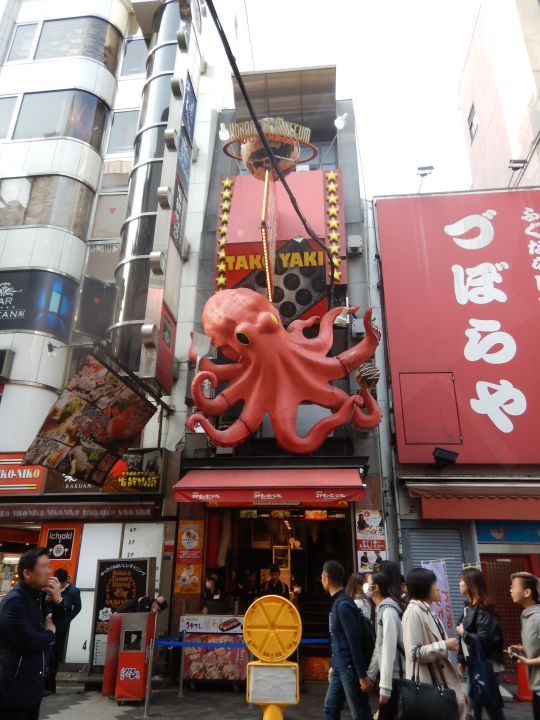

We also played in an Arcade. We played a Dungeon’s and Dragons game together. We then met up with a friend I had made on the app Hello Talk. He took us to this wonderful Tuna restaurant. We ate delicious fried tuna ribs, we tried sushi, and sashimi.
He gave us a beautiful gift each. They were chopsticks with our names and lucky animals.
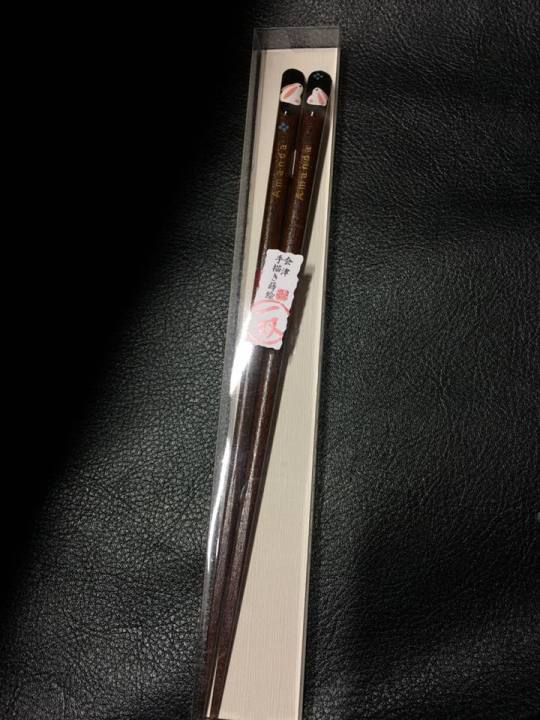
The next day, we met up with Yuuka again, and she took us to visit Himeji Castle. It was a rainy day, but it was still a lot of fun! We stopped at ate food on the way too!
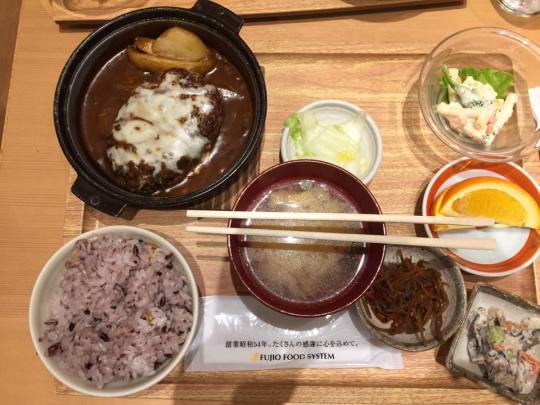
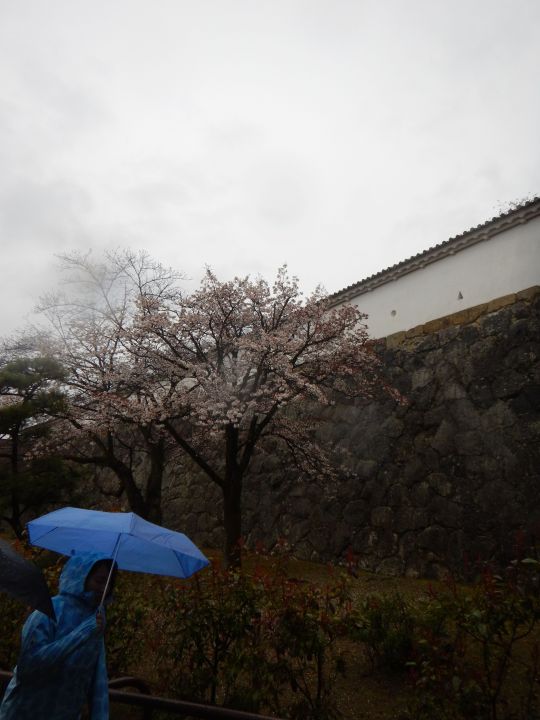
After this, we did some shopping, and ate at Cafe de Miki. Which is a Hello Kitty themed Cafe!
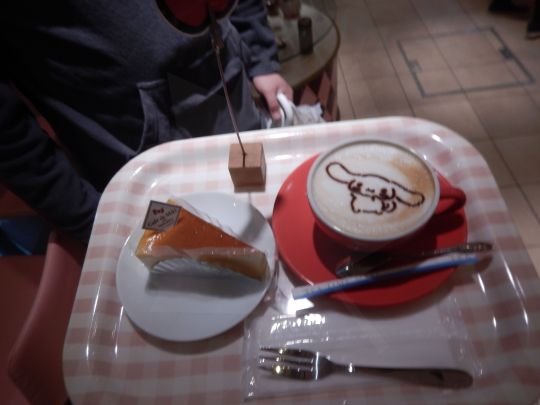
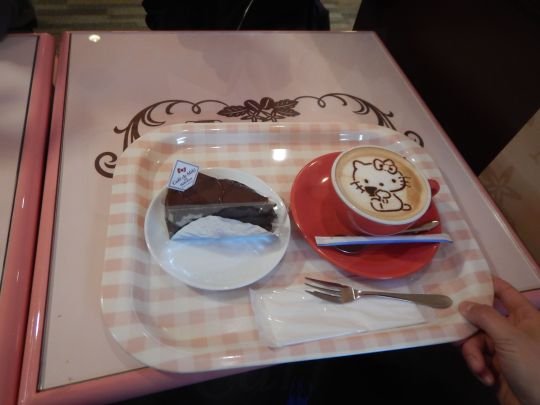
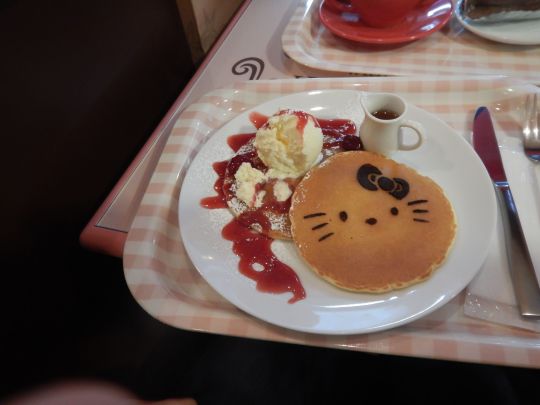

We then met up with Yuuka’s mother, whom I had the pleasure of meeting. We exchanged gifts and they saw us off on our train to head back to Tokyo.
One of these gifts was this delicious unagi bento box that Himeji is known for.
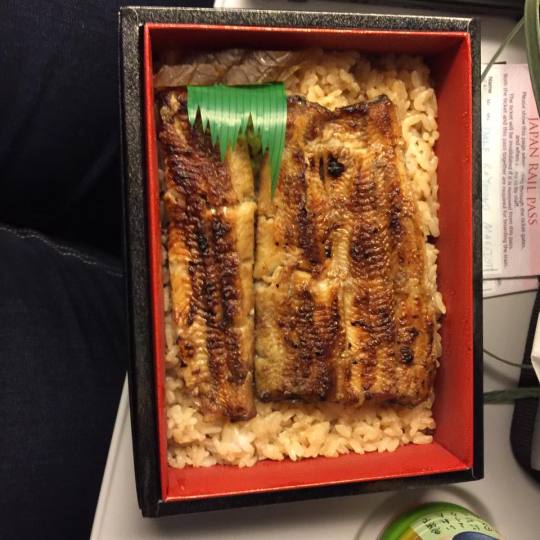
The next day, we went out on our last adventure for the day. We visited Super Potato where we picked up some games and our traveling companion picked up a Super Famicom.
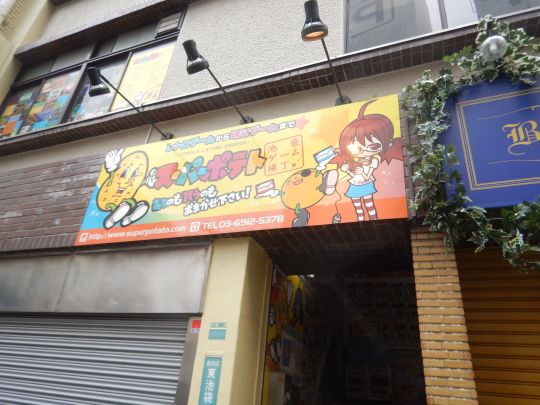
After this, it was time to get ready to leave. We packed our bags that night and headed to the airport early the next day. Everything went smoothly for us, and we got through quickly. It was sad to come home. I would definitely love to live in Japan one day!
Here is a bit more of Japan that I didn’t know where to squeeze in else where! I met a toilet I hate, and toilets I love while I was there. You have regular toilets, squat toilets and what I like to call super toilets. I love these fully loaded toilets. They have bidets, some have things to dry you, heated seats, and some make noise so others can’t hear what you’re doing!
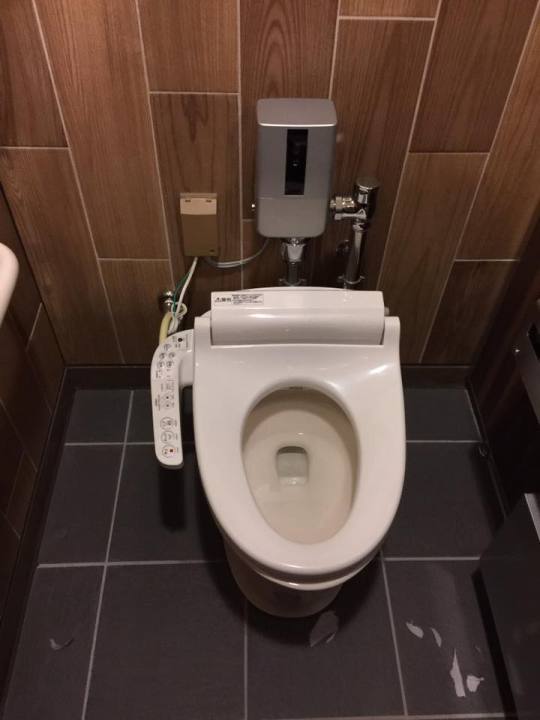
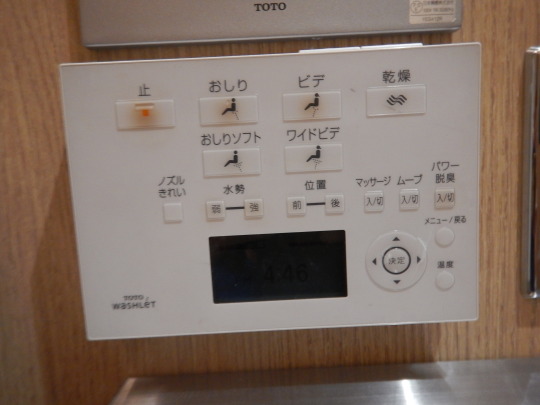
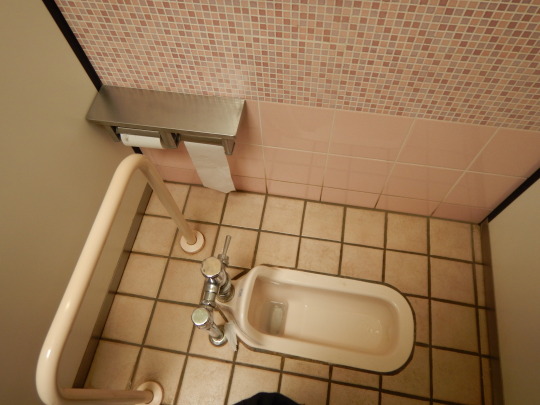
I also took pictures when I found stores I recognized from home. Some won’t be surprising. However, I was totally surprised to find out Kumon was from Japan! I only ever knew it from here.
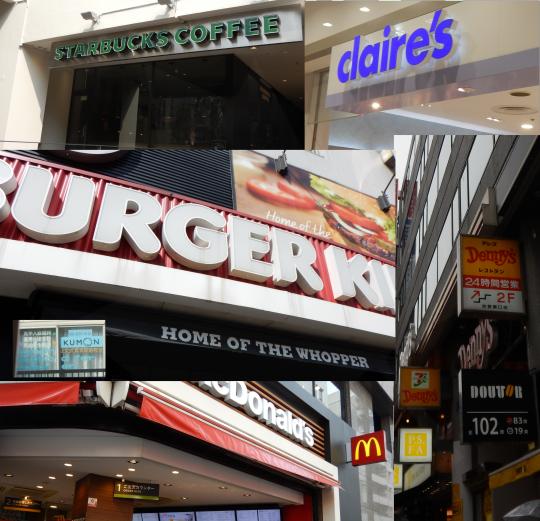
That’s all I have for now! I hope you enjoyed my trip through Japan!
#japan#delays#flights#toronto#halifax#canada#ueno park#square enix cafe#akiba#akihabara#shinjuku#jackass penguin#signs#caution crow#food#waterfall#ueno zoo#kyoto#fushimi inari-taisha#shrine#torii#dotonbori#disneyland#crepes#sugar#beautiful#stunning#walking#tuna#sushi
2 notes
·
View notes
Text
T&J Travels #10: Japan 2018 (Part 7)
Today involves a lot of walking. Our original itinerary is fully packed with so many places and this is our attempt to finish as much from our list. We did try to start early today but we've still arrived at our first stop almost 10 AM already (Shin-Osaka to Arashiyama is more than an hour away). Technically we are already late for everything.
+ Arashiyama Bamboo Grove + I do not know if all routes go to the bamboo grove but we only followed a tour group just so we could reach it. We thought we were already there seeing the thin bamboos around but after some 5 minute walk (with a few stops as selfies) we finally arrived at the famous grove.
We roamed for a while, even to places until the crowd thinned more. After the grove we've went for quick snacks crab sticks and dango. We also found a weird snack: yuba soup! It's layers of tofu skin and tofu soup (300JPY a cup). The warm soup is comforting in this airy Kyoto.
Price: FREE; There is bike rental though in case you wanted to get ahead of everyone else.
+ Toei Kyoto Studio Park +
It is rare for an IT to include the Toei Studio park. But being raised on anime, I thought it would be a disgrace not to go.
When we got in we are greeted by anime figures both old and new. There's also cute themed eating areas at the side. We spent sometime ogling at them until we've finally went out and so glad we did. It's like we've transported to an old Japan!
Tip: Wait for the special surprise!
Other than being a theme park, it's also a live studio for Toei so all are locations that could eventually be a set in any of their shows. Even the building we've been in looked like an old train station complete with a life sized train in front. There's Yoshiwara street (red light district), a body of water that could resemble a port or any location that needs water (with a special surprise every few minutes!!), a front of a temple, a village amongst others. We've also stumbled on a few actors who are currently shooting a scene and had to close off a certain area. We were told not to take photos though. Too bad I didn't know who the actors were.
There are also roaming samurais and geishas who you could take photos with but we were too shy to ask so I had just this stolen shot:
While we were roaming we spotted an ongoing session of actors role playing with kids. It's unfortunate we couldn't understand what they were saying but hearing all the laughter makes me really envious.
After enjoying what outside offers, we've went back to the main building and went upstairs to Hero Land where all the life sized statues of different Sentai are in display. Reagan grew up watching them (I myself could barely remember!) which made the attraction extra special to visit.
We left and had missed a proper meal. We got some onigiri at the nearest Mini Stop and had to walk in circles looking for the bus stop until we realized it was just in front of the park.
Price: 2200 JPY (each) + Kinkaku-ji +
We were lucky to have made it before the cut off time (5PM) and at the best time to view it as well. The temple lived up to it's name as being Golden, but seeing it illuminated with the last rays of the sunset gives it an extra glow.
I also liked that there are not much people around too so we were able to get a lot of spots to take photos.
The actual temple is off limits so you just have to admire it from a far. We've walked with the rest of the tourists around the temple. There's a gift shop and fortune telling boxes. I was curious in trying out one but as soon as I've decided to get one, they started to cover them as sign of being closed. Price: 400 JPY + Kyoto Tower +
When we got off of the bus, we have no idea where to look for the tower. Only until I glimpsed it on a reflective surface did we notice we only need to look up. We walked towards it, even made it up to inside but didn't went up. I don't know what have gotten into me, but best thought not to for the moment. Besides I wanted to go back to this building to try out the making of fake food and kimono wearing we saw in one of the floors.
Price: Can't remember since we didn't went up. + Fushimi Inari Taisha +
Just when I thought that we'd be coming home already, Reagan suggested we still go. I know that we don't need to hastily go there (being open for 24 hours) but I was worried of the time we would spend actually going there. So imagine my surprise when I found out that the train station is right next to the location itself! You just literally have to tap your train card and already see an orange Torii to welcome you.
While it's a good experience to see Fushimi at night, both my gadgets suck bad at low light photography so I have no decent photos and these are the best I could do:
I've read from somewhere that it would take a long time to hike to and fro the thousands of the torii so obviously we couldn't do that for tonight. I am just happy to have seen it finally even on an odd time, but I suppose it's always easy to come back here someday.
Price: FREE
After a dinner of udon we eventually settled for the night. If memory serves my knees started to hurt with how cold Kyoto was. I would love to go back to Kyoto but because of this I wouldn't wish to come back at late spring. That or I really need something to hide my knees from the cold.
0 notes
Text
Japan, We Love You
When handing out awards, Japan is the dark horse of our trip. We didn’t know much about the country or culture, nor did we know many people who’d visited. We’d traveled through 11 countries in Asia at this point. We’d been through Africa, the Middle East, and South America and had traveled constantly for the past 9 months. We got comfortable and felt that nothing could surprise us. And as usual, the world proved us wrong.
Japan’s culture is unlike any other in Asia, which is a good (incredibly clean) and bad (incredibly expensive) thing. Incredibly conservative and polite, there is a huge emphasis on respect, manners and honor. We learned some of our favorite customs here. For instance, one never turns their back on a customer. So when a conductor travels through one of the high speed bullet trains and must turn his back in order to walk down the aisle, he turns around at the end of every train, takes his hat off and does a very deep bow. This is at the end of EVERY single car.
Or, there is absolutely no tipping. So when you accidentally leave money on the table, one of the waiters will chase after you to return it!
And then there’s the food. Another surprise. Japan is a foodie paradise with an incredibly wide range of traditional dishes and you’re sure to find one you’ll love. From sushi to ramen, you could eat a traditional dish every night for a month and not repeat. We’ll recount some of our favorites as we go through our itinerary.
We started in Tokyo at Anne Hostel. Unfortunately, Japan is more expensive than other places on our itinerary, so we kept accommodations simple so we could splurge on experiences. We immediately set to work seeing the sights.
First on our list was the famous Tsukiji Fish Market. About 2,000 tons of seafood is traded here daily, but the most sought after sight is the Tuna Auction held in the VERY early morning. We got up at a casual 3AM in order to earn the privilege to watch this auction in action. Experts from the best restaurants in the country review these gigantic tuna shipped to port in the past night, and then a Japanese man spouts off prices until the highest bidder is found. We’d seen a lot by now, but this experience was bizarre.
The next day we continued to hit Japan hard. We headed to the Meiji Shrine, which is located on a park of 170 gorgeous green acres. The shrine is dedicated to the deified spirits of Emperor Meihi and his wife Empress Shoken to commemorate his role in the Meiji Restoration. (Pssst the Meiji Restoration was in 1868, when Japan realized how behind it was from the West, it opened up its doors to foreign trade and technology. This was further done after WWII, and is the reason the country is so changed from our grandparent’s generation to ours). The shine and park were beautiful and wonderfully peaceful.
On the walk home, we experienced Tokyo’s fashionable district and soaked up the glamorous beauty that is Tokyo. We. Love. Cities.
Next we headed to the Imperial Palace, which is the primary residence of the Emperor of Japan. The grounds and architecture were gorgeous.
Next, we took advantage of our incredible luck to be in Japan during the Sumo Wrestling Championship! The Japanese absolutely LOVE sports (more on that later). Sumo is their national sport and indicative of their deep heritage. It is a ritualistic form of wresting from ancient times involving two overweight men clothed in loin cloths with their hair in topknots (like hipster man buns) battling out their strength to try to force their opponent out of the circular ring or into falling to the ground. Though that is the technical explanation, there is much more to it than that.
Sumo wresting isn’t just a sport, it is literally a way of life. As usual with the Japanese, they go all in. The wrestlers are required to live in a heya where they train and live. Their diet and lifestyle is heavily regulated. These guys may look fat, but in real life you can see they are HUGE mountains of muscle and disarmingly flexible. These mountains crashing together was a sight we’ll never forget.
After the sports, we needed to support the arts! We did so by visiting one of the largest art museums in the world: The Tokyo National Museum. Located inside a beautiful Ueno park, the museum is dedicated to art works and archaeological objects of Asia with a particular focus on Japan. We finished off the day with a walk through Otaku, Tokyo’s anime or gaming district (Japan is OBSESSED) with skyscrapers covered in neon lights and anime characters dancing around us!
All of this touring made us hungry and we visited one of our favorites (that we even came back to later!). Kikanbo Spicy Ramen. The craving returns just by typing the name!
After Tokyo we headed to Kyoto, which is considered the cultural capital of Japan due to its rich history of the Imperial time. The city holds the vast majority of Japan’s National Treasures and UNESCO World Heritage Sites and is obviously a must if you travel to Japan. Even the Japanese citizens go here to learn more about their own heritage.
The Arashiyama Bamboo Forrest is a gorgeous must, and it transports you to another planet. A quieter planet. Be sure to get there early as it is a (rightly so) popular spot.
Another must is Fushimi Inari-taisha, which is the mountain shrine that holds the pathway with the thousands of iconic orange gates. We were grateful to have each other on the two hour walk, as once you get lost in the pathways, the sound disperses and it becomes eerily quiet and isolating. Though it is technically one shrine, it holds as many as 32,000 sub-shrines.
Now, it is time for a confession. After the sumo wresting match, we went to dinner with an Australian couple who sheepishly asked us if we liked Harry Potter. Blakely tried to play calm and casually said yes. They then proceed to tell us about the UNBELIEVABLE Harry Potter World located at Universal Osaka. Even though the couple weren’t fans themselves, they were impressed. Again, Blakely tried to act casual, but Ryan received multiple kicks under the table which communicated that their plans were set.
If you get the opportunity, the Japanese culture is made for theme parks. The impeccable cleanliness, unwavering respect to strangers, and relentless cheerful demeanor make them the perfect hosts in this imaginary land. Plus, they’ve got the funds and the following to invest in these ventures, and the Harry Potter world alone received an investment of over $400 MILLION. We couldn’t help but be taken in, and were grinning madly from the moment we got in line.
OF COURSE, Harry Potter world was the first place we went. We’ll let pictures describe the utter joy that filled Blakely’s being. It was complete system overload. While standing in line for a ride (The Flight of the Hippogriff, thank you for asking), Blakely asked Ryan urgently for 5,000 yen (about $50). This was A LOT for our world trip daily budget, and far more than the souvenir department ever requested on a whim. She offered no explanation but Ryan handed it over. 10 minutes later, Blakely came back with her very own Harry Potter wand. Yes, these wands perform magic in the park (she hasn’t tried since leaving because she’s worried about breaking the International Statute of Wizarding Secrecy).
We went on to enjoy TONS of rides and calls to our childhood like Jaws and Jurassic Park. We consumed cheesburgers and huge cokes with tons of ice. We walked down the streets of “New York” and ended the day at TGIFridays. Then almost fell asleep in utter exhaustion on the ride home. It was a wonderful day.
And the treats weren’t over, because next we headed to a Glamping.com assignment in Miyama with some of the most charming people we’d ever encountered. Read about the amazing experience in our gorgeous thatch roof hut here.
Of course, another must is to view the ruins in Osaka, where the US dropped one of two atomic bombs during World War II. We were there for the historic visit from President Obama, and it was an honor to be present as our two countries met to continue the healing from that horrible time.
Lastly, we headed to the mountains for a little relaxation. It’s a fairly well kept secret that Japan has some of the best skiing in the world. While we were there during off season, we still got to enjoy amazing hiking as well as a Japan highlight and a Blakely delight: The onsen.
An onsen is a Japanese hot spring with spas, inns, and bathing facilities built around them. Since Japan is volcanically active, thousands of onsens are scattered throughout the country.
We were very skeptical. Firstly, it’s intimidating because, like many traditional Japanese activities, onsen bathing is seeped in etiquette. We shouldn’t have been hesitant, because also like other traditional Japanese activities, the rules are clearly explained and (even better) make sense!
So the onsen ritual is essentially bathing in a hot spring. This used to happen with both men and women, but since the Meiji Restoration the bathing has been separate.
The main etiquette for onsen bathing is ensuring cleanliness before you get into the bath. There are showers with toiletries, and you are expected to clean yourself THOROUGHLY and rinse off absolutely all traces of soap before entering the onsen. Love this rule.
Bathing suits are normally not permitted, and towels and wash clothes are normally not allowed to be dipped into the bath. This is all to preserve cleanliness.
Onsen bathing was absolutely one of the most relaxing things we’ve ever done. The only regret is not finding one in every city!
We ended our Japanese adventure back in Tokyo where we experienced entertainment unlike ANY other in the world. A Japanese baseball game.
Yes. The Japanese absolutely love baseball. While the game resembles its American cousin, it has been Japan-i-fied with choreographed cheers, multiple life-size mascots, and skimpily dressed beer girls. Our seat neighbors promptly lent us gear in the proper colors once they realized we didn’t have any team paraphernalia, and the stadium was perfectly clean when we left. Such a cool experience.
As we said at the top, Japan was the dark horse of our trip. No place delighted us more, surprised us more, or welcomed us more. We can’t recommend it highly enough, nor wait to go back.
0 notes
Text
Notre sélection de livres dédiés à l’art, la littérature et la belle photographie de voyage
Notre sélection de livres dédiés à l’art, la littérature et la belle photographie de voyage
Notre envie sera de partager un coin de notre esprit, plein de lectures et de belles images, comme une conversation avec nos lecteurs. Voici notre sélection de livres de voyage les plus inspirants de notre bibliothèque. — Carnets de traverse a souvent placé le livre et l’inspiration littéraire au cœur de ses articles de voyage. Il y a tant à dire, tant à partager — tant de travaux remarquables qui enrichissent notre vision.
Aujourd’hui nous vous proposons d’explorer des atmosphères et des mots autour du land art, de l’ethnographie, de l’autoportrait, de l’Ektachrome américain, et d’autres belles choses encore ! Retrouvez notre premier opus ici
Notre sélection de livres :
75. Christo and Jeanne-Claude California, Kourtney Roy Genesis. Sebastiao Salgado Modern Color. Fred Herzog Atlas des Iles Abandonnées. Judith Schalansky A Way Into India. Raghubir Singh The New York Times Magazine Photographs, Kathy Ryan Beyond The Wall. Justin Jampol Quelques livres en plus : Jack Kerouac, Corto Maltese,…
1. “75”. CHRISTO AND JEANNE-CLAUDE
C’est une pure merveille éditoriale, consacrée aux artistes contemporains Christo et Jeanne-Claude. Ils sont connus pour avoir empaqueté le Reichtag de Berlin, le Pont Neuf de Paris ou encore avoir installé 7 500 portes drapées en orange, sur 37 kilomètres à travers Central Park !
Au sujet du projet The Gates à Central Park — Pour ceux qui ont visité au Sud de Kyoto le sanctuaire Fushimi Inari, cela leur rappellera quelques similarités visuelles. (…)
On leur doit des interventions artistiques dont la puissance visuelle ont marqué la conscience collective : Valley Curtain (1972) un gigantesque rideau barrant une vallée en Californie — Surrounded Islands (1983) des îles de Miami entourées de polypropylène rose — ou Parasol Bridge (1991) des milliers de parasols faisant un lien entre Japon et la Californie !
C’est toujours spectaculaire, monumental, symbolique à souhait, très cher (financé exclusivement par la vente des esquisses préparatoires du projet) mais extraordinairement fort !
Tout étudiant en Art à un jour ou l’autre rêvé devant la qualité et la maîtrise des dessins de Christo. Pour avoir vu certaines de ces œuvres en galerie, je peux vous garantir que ces esquisses sont éblouissantes. (…)
Plus récemment, à l’été 2016, Christo a relié le village de Sulzano à l’île de Monte Isola et celle de San Paolo — via des grandes plateformes couvertes de ce orange qu’il affectionne tant ! Plus d’un million de personnes ont marché sur les eaux du lac d’Iseo ! Pas mal tout de même !
Ce coffret est en tirage limité, totalement hors de prix. Mais Taschen fait en règle générale très bien les choses, et la maison d’édition sort assez rapidement des versions plus accessibles.
Christo et Jeanne-Claude sont de merveilleux artistes, avec une vision de l’ailleurs tout à fait brillante et une créativité extraordinaire !
“CALIFORNIA”. KOURTNEY ROY
Louis Vuitton Fashion Eye est une collection de livres de voyage, éditée en 2016. Carte blanche est donnée à un/une photographe de mode afin de partager sa vision d’une ville ou d’un pays.
Ici c’est la photographe canadienne Kourtney Roy qui se met en scène (sorte d’autoportrait) dans des compositions iconiques de l’Ouest américain.
Je suis un grand fan du travail de cette jeune femme, un talent incroyable ! Tout est canon, parfaitement maitrisé et organisé dans ses images. Les couleurs, les cadrages, le choix des espaces, l’iconographie. Tout y est ! (…)
Chaque image est un tableau entre réel et une pointe de fantastique — on y trouve des inspirations des années 50, 60 ou 70. Ce qui est assez fascinant chez cette photographe c’est la grande liberté qui se dégage de ses images. On y ressent un grand “je fais ce que je veux, comme je veux”. (…)
Regardez attentivement chaque image et vous verrez que rien ne manque dans cette volonté de crier et de s’approprier l’Ouest américain. C’est à la fois plein d’humour, un peu barré mais toujours élégant et chic. (…)
Tout est étonnement dans l’air du temps (on voit beaucoup de ces compositions sur Instagram) mais à la fois ce n’est pas si simple d’y voir des repères de notre époque. Ces images pourraient avoir été prises dans les années 70, 80 ou 90. Cela les rend intemporelles… Artistiques ? (…)
Chaque image possède son mythe de l’Amérique. Kourtney Roy joue avec les codes de façon très subtile, très habile. L’alchimie visuelle qu’elle arrive à créer sur chaque image est vraiment d’une grande créativité. Cela force toujours le respect !
La collection Louis Vuitton Fashion Eye s’est enrichie cette année de nouveaux opus. On peut citer Saul Leiter, Peter Lindbergh, Helmut Newton, Sølve Sundsbø ou encore Vincent Van De Wijngaard.
Le façonnage des livres est impeccable. Selon le photographe et la destination, le papier et les mises en page changent du tout au tout ! Pour Shangai c’est du papier de soie imprimé qui accueille le travail de Wing Shya, des papiers ultra-brillants pour d’autres opus,…
Ce sont des grands formats de plus de 30cm de haut — Et le prix fait mal : 50,00€ l’unité (Kourtney Roy -> ISBN: 978-2369830856).
“GENESIS. SEBASTIÃO SALGADO
“Genesis“ est un ouvrage désormais culte, dédié à l’exploration de notre terre, en noir et blanc s’il vous plait !
Sebastião Salgado a parcouru le globe pendant huit ans à la découverte des espaces naturels encore préservés et des peuples épargnés par l’hyper-quotidien. Il y a dans cette démarche les mêmes désirs d’exploration (et de sauvegarde désormais) que les grandes épopées des découvertes du XIXeme et début du XXeme siècle. (…)
Les prises de vue alternent des rencontres saisissantes d’hommes et femmes dans leurs espaces de vie, des portraits, des scènes animalières extraordinaires — et des vues aériennes à bord d’un petit avion qui l’utilisa pour se déplacer à travers les pays. L’usage du noir et blanc donne une dimension presque sacrée, biblique à ce patrimoine qui part en morceau, jour après jour. (…)
Salgado excelle dans son art du noir et blanc, saisissant des scènes de vie qu’on peine encore à imaginer à l’heure de notre quotidien digitalisé.
Eleveurs-nomades Dinka du Soudan, peuple Korowaï vivant à l’âge de pierre en Papouasie occidentale, communautés Mentawai à l’Ouest de Sumatra,… C’est un témoignage monochrome d’une grande beauté, d’une élégance rare.
Le projet “Genesis” a commencé en 1994 et s’est terminé en 2012. J’imagine que la vocation première de ce travail photographique est certes la conservation mais aussi l’inspiration auprès de toutes les générations. (…)
Comme je l’ai précisé pour “75” de Christo et Jeanne-Claude, “Genesis” existe chez Taschen en plusieurs éditions — allant du “Sumo” (Double volume de 50x70cm – 3 000,00€) au plus modeste mais tout aussi beau format standard (24x35cm – 50,00€ – version française (ISBN 978-3836542616). C’est un très beau livre, bien fabriqué qu’il faut avoir au moins feuilleté. Très inspirant !
“MODERN COLOR”. FRED HERZOG
C’est un street photographer et pionnier de la pellicule argentique couleur Kodak Ektachrome. Hatje Cantz publie ce magnifique ouvrage en compilant 50 ans de travaux du canadien d’adoption (allemand d’origine) Fred Herzog.
Le livre est brillant ; la curation des images est soignée ; le style Herzog est flamboyant. “Modern Color” est un petit chef d’œuvre de la photographie nord-américaine couleur ! (…)
Je dirais que c’est l’âge d’or de la street-photographie, la ville possède encore une esthétique incroyable faite de néons, d’enseignes publicitaires sophistiquées, de voitures mythiques à chaque coin de rue.
Le regard d’Herzog sur ce Vancouve qui n’existe plus est plein de poésie et de douceur. Les enseignes de barbier deviennent des compositions-icones dignes d’un Hopper. Les boulevards sont des romans graphiques, une ôde à la ville ! (…)
Le travail de Fred Herzog a émergé depuis une dizaine d’années tout au plus. Dans la foulée des grandes redécouvertes des photographes-coloristes des années 50 à 70 ! Saul Leiter, William Egglestons,…
La tradition de la photographie noir et blanc rendait à l’époque la couleur comme un “sous-art”, une “marotte digne d’un enfant”.
Henri Cartier-Bresson disait de la photographie couleur :”elle est bien fade malgré ses tons”. Comprenez par là, le noir et blanc offre de très larges gammes (de gris), la couleur non ! (…)
J’évoquais le travail de reportage de Sebastião Salgado, œuvre de conservation de la nature et des hommes — J’ai tendance à croire que le travail d’Herzog s’inscrit dans la même lignée : capturer des instants d’une ville en pleine mutation, dont l’esthétique se dégradera inévitablement.
Les détails, les couleurs un rien pastel, les compositions faussement non composées : tout cela est simplement sublime ! (…)
L’ouvrage “Modern Color” est un bel objet, bien façonné, avec de belles mises en page, de beaux choix typos et un papier agréable à feuilleter. Hatje Cantz a bien fait les choses et pris soin du travail d’Herzog. Le prix est très raisonnable – 32,00€ – pour 320 pages, format carré (ISBN: 978-3775741811). Un très bon livre tout simplement.
“ATLAS DES ILES ABANDONNÉES”. JUDITH SCHALANSKY
Je lis régulièrement ce petit atlas paru en 2010 et sorti de l’imaginaire de Judith Schalansky. C’est un bijou de sophistication éditoriale. Le fond et la forme sont canons — les textes sont ciselés, le graphisme est magnifique, l’objet est bien réalisé.
Le thème même des îles abandonnées, le plus souvent habitées d’ailleurs, est génial. Une grosse heure de lecture suffit à absorber ces beaux textes et les formes incroyables de ces îles. (…)
Les compos typos, le choix du papier, les blancs tournants,… tout participe à créer une adhésion avec ce livre et ce thème. Je me dis systématiquement que la personne qui a créé cet ouvrage aimait réellement ce qu’elle composait. On y retrouve de faux airs des livres du XIXeme siècle, parfaitement assumé par l’auteur selon moi.
L’introduction d’Olivier de Kersauson est très belle. Un tout petit extrait :
“Les Îles abandonnées sont comme toutes les îles des bateaux immobiles. Une façon d’être sur la mer sans être obligé de travailler ; un bateau que l’on ne commande pas, et qui permet d’être un navigateur paresseux. Mais celles-là n’ont ni capitaine ni habitants. Morceaux de roche ou de corail découverts par hasard, visités parfois, rarement habités, souvent désertés…” (…)
C’est le type d’ouvrage qui inspire une envie d’ailleurs et de découverte du monde. Pas de projection autre que des petites illustrations, pas de photos “stunning”, juste des mots et beaucoup de sensibilité — je devrais dire beaucoup de talent et de créativité.
Le livre est vendu un bon prix – 25,00€ – pour 144 pages et 50 îles disséminées dans tous les océans du monde (ISBN: 978-2081238206). Un bon livre à avoir dans sa bibliothèque.
“A WAY INTO INDIA”. RAGHUBIR SINGH
Le nom ne vous dira peut-être rien, photographe moins connu en Europe. C’est aussi un pionnier de la pellicule couleur qu’il va mettre au service d’un style documentaire ciselé.
Moins “raconteur de contes enchantés” que Steve McCurry, le travail de Raghubir Singh n’en reste pas moins exceptionnel par sa valeur. Très influencé par les travaux documentaires de Cartier-Bresson, Singh a travaillé pour les plus prestigieuses institutions : National Geographic ou The New York Times.(…)
“A Way Into India“ est un recueil d’images édité en 2002 et dédié à la voiture Ambassador, qu’il utilisa dans tous ses déplacements en Inde, durant de nombreuses années !
Plus qu’une voiture, l’Ambassador devient un prolongement physique de son appareil photographique. Il ouvre les portes, cadre avec les fenêtres, utilise les vitres, les reflets… Le tout est porté par l’intensité des atmosphères indiennes. C’est un très joli petit livre, avec de belles séries d’images. (…)
Raghubir Singh capte des moments particuliers, souvent modestes autour de cette voiture emblématique de l’Inde. Remise dans le contexte de l’époque, ces images couleurs était très nouvelles.
Regardez bien comment le photographe cadre ses images, où est le milieu, les lignes de tension, les ombres qui amènent le regard vers la voiture — Rien n’est laissé au hasard, je vous le garantis ! (…)
“A Way Into India” est un petit livre à 27,00€ chez Phaidon (ISBN: 978-0714842110) qui continue à l’éditer depuis plus de 15 ans. Toujours intéressant de voir comment les photographes documentaires mettent de côté le “trop” pittoresque pour saisir ce petit truc en plus qui donne une belle profondeur à leurs travaux. Un très bon livre !
PS : les images de la composition du dessous ne font pas partie du livre et sont extraites d’autres ouvrages de l’auteur.
“THE NEW YORK TIMES MAGAZINE PHOTOGRAPHS”, KATHY RYAN
C’est un livre que je n’avais pas eu l’occasion d’ouvrir depuis pas mal de temps. La diversité des meilleurs travaux du New York Times Magazine est saisissante.
Pour rappel, le NYT Mag. est un cahier supplément de l’édition du dimanche du New York Times.
La première de couv. du magazine est un enjeu professionnel de haute-voltige. Quand un photographe annonce qu’il a illustré la couverture du NYT Mag., sa carrière change rapidement ! Les illustrations faites pour New York par exemple donnent des images fortes, allant des streets de la Big Apple, traitée par Lars Tunbjörk ou Philip-Lorca di Corcia…
…au plus énigmatique des visuels de Clint Eastwood photographié par Inez+Vinoodh — ou encore les Twin Towers par Rodney Smith. (…)
Et que dire de cette magnifique couverture montrant Times Square par temps de pluie, vision kaléidoscope, créée par Jack Pierson !
Le livre est cher, beau, très spécifique sur la photographie de commande pour le presse. Toujours intéressant car le New York Times est une référence ! 50,00€ chez Aperture, 448 pages, (ISBN: 978-1597111461).
“BEYOND THE WALL”, JUSTIN JAMPOL
Un des livres fétiches que Julie aimait feuilleter de temps à autres — entièrement dédié aux produits, objets et autres outils de consommation de l’Allemagne de l’Est.
Une sorte d’annuaire bien vintage de la culture visuelle de la RDA, brillamment mis en page par Taschen. Si vous avez l’occasion de le feuilleter, vous resterez scotchés ! (…)
Tout y est… Postes de radio, boites de conserves, étiquettes en tout genre, livres/diapositives érotiques, architectures soviétiques, brochures, timbres, manuels scolaires, affiches politiques, calendriers, mobiliers, billets de loterie,…
Bref, c’est bluffant, émouvant, presque addictif — c’est un voyage très intéressant dans une Allemagne complètement inconnue. C’est un format XL de chez Taschen, donc 5kg, donc 900 pages, 32x22cm, le prix est fixe : 100,00€ ! Pas donné (ISBN: 978-3836548854)
“QUELQUES LIVRES EN PLUS :
• “Folio BD” : ils deviennent petit à petit des classiques de la BD. Les Folio BD dédiés à Hugo Pratt et son Corto Maltese sont très très chouettes ! On vous les recommande. 7,65€
• Ernest Hemingway et Jack Kerouac sont chez Gallimard Quarto (œuvres complètes donc). Deux grands auteurs pour une collection que j’affectionne particulièrement. 35,00€
• La Pléiade : les mêmes textes que les Gallimard Quarto, simplement change l’objet. Relié cuir, doré à l’or fin, papier bible. Ce n’est plus du tout le même rapport au livre, voire même au texte. J’en possède quelques-uns. Jules Verne et Philip Roth sont désormais à la Bibliothèque de la Pléiade. C’est un honneur tout de même. Environ 60,00€
• The Art Museum de Phaidon est un SUBLIME parcours dans l’Art des hommes — depuis le tout début de l’humanité jusqu’aux courants contemporains les plus alternatifs. La mise en page dépoussière tous les guides existants sur le marché ! J’aime offrir ce livre à des proches qui s’intéressent doucement à l’art. Tout devient alors accessible et bien cool !
Il existe en plusieurs formats : allant de 50,00€ pour les standards à 95,00€ pour le beau format XL, devenu difficile à trouver. C’est un livre remarquable !
Cet article Notre sélection de livres dédiés à l’art, la littérature et la belle photographie de voyage a été publié sur ✖ Carnets de traverse.
http://ift.tt/2HkoNsD
1 note
·
View note
Text
Tokyo is the bustling capital. Osaka is the wild port city. Kyoto is the former capital and now historic heart of Japan. Hiroshima, though, is the city that has captured my interest and heart.

Hiroshima from Hiroshima Castle.
Sure, Tokyo is one of the most famous and biggest cities in the world. It’s glitzy, trendy, and crowded. The last quality mentioned is what keeps it off the top of my list. I like going into the city for the day or night, but after negotiating the busy streets of Shibuya, Shinjuku, Asakusa, Iidabashi and other popular neighborhoods, I am ready to get back to my small commuter town on the outskirts of the city. Don’t even get me started on the trains. While they are not too bad during the day, around rush hour and for quite a few hours after, they can be quite unpleasant. Crowds just aren’t my thing.

Cherry blossoms in Tokyo. Massive crowds every year.
Osaka is a fun city. Much less crowded than Tokyo. I’ve only spent a few days there, but I enjoyed the city. The natives of Kansai have a bit of reputation for being, well, a bit wild. Of course, I hear this from people who have lived in Kansai most or all of their lives, so I think their bias is showing. There is a long-standing rivalry between the Kanto and Kansai regions. I’m not going to delve into that quagmire here. There has already been plenty written on the topic by people who are much more knowledgeable than I. Besides, that is not the point of this submission. All I will say is that I spent three fun days in Osaka and found the people to be very helpful and friendly. Every time I got off a train and even looked at a map I had an Osakan run up to me and offer to help me and even give me suggestions on what to see and where to go. I have never had that happen in Tokyo. Hell, I have had people practically run away from me when I asked for directions in Tokyo. Even though I enjoyed myself in Osaka, I haven’t felt the desire to go back.
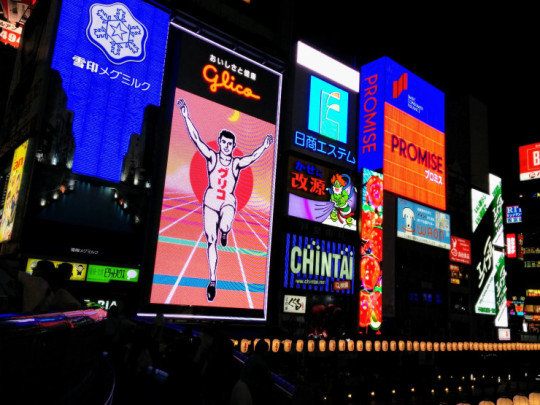
Dotonbori area in Osaka.
Kyoto is definitely a place I need to revisit. I only had one day to spend in Kyoto and that is not nearly enough time to see everything there. I was able to hit most of the big spots, but I enjoy exploring the less crowded and out of the way places in cities just as much as the highlights. A city with as much history as Kyoto has stories to tell in every back alley and sidestreet.

Kinkaku-ji, one of the most popular buildings in Japan.

Hiroshima Memorial Peace Park from the Motoyasu River.
Hiroshima, for better or worse, is probably known to most as the site of the dawn of the nuclear age. While the A-bomb dome and Peace Memorial Park and Museum dominate most tourists to do lists, there is much more to Hiroshima than that dark time in human history. Obviously, if you do go to Hiroshima, you must see the park and go to the museum. I am convinced that anyone who visits the museum and sees the end results of atomic weapons will be in favor of destroying these weapons once and for all. The first time I went to the museum, it was possibly the quietest place I have ever been. The rooms were quite dark and visitors were surrounded by everyday items that survived the blast. Melted bottles, burned clothing, bubbled roof tiles, and a misshapen tricycle made for a somber atmosphere. The thought that a kid may have been on that tricycle when the bomb exploded and melted everything made of flesh within the blast radius cast a gloomy pall upon my mood. There was absolutely no conversation or a smile to be seen in the museum. Considering the subject matter, I think the curators got it just right.

The iconic A-bomb Dome.
However, I returned to the museum this summer and it had completely changed. The museum had undergone a complete renovation. Gone were the dark rooms and in their place were interactive computer screens, bright lights, and monitors showing old movie footage. I have to admit that there was a great deal more information on hand and I learned a lot of details that led up to the decision to drop the bomb. But the intimacy and somber atmosphere were completely gone. Kids were running around the place, tourists were making inane comments about travel saving the world and other nonsense that made it feel more like I was in an amusement park. While I still recommend going to the museum, I think the intent of being a voice for deterrence has been lost.

A-bomb Dome as seen through the Memorial Cenotaph.
Yes, the A-bomb dome and Memorial Peace Park are the dominant features of Hiroshima, but there is more to the city than that horrendous singular event. Hiroshima, along with the rest of Japan, has a long history. Not far from the Memorial Park is Hiroshima Castle. It is a small, but very nicely restored castle. It was built in the late 1500’s, destroyed by the atomic bomb, and rebuilt in 1958. It now serves as a museum to life in the Hiroshima area before the war. I am a huge fan of Asian castles. I just love the architecture and history behind them. The castle and grounds surrounding the castle are definitely worth a look. There is more history to experience just a short trip from Hiroshima. You can take a train and a ferry to Miyajima, home of the World Heritage Site Itsukushima Shrine.
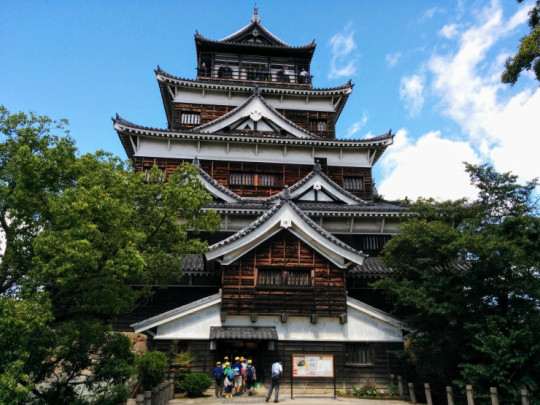
姫路城

The famous “floating” torii of 徳島神社.
Itsukushima is probably best known for its floating torii. The gate, which you can walk right up to during low tide, shines in bright orange and is reflected in Hiroshima Bay at high tide. The entire shrine is built above the water but in the two times I have been there it was low tide so I have not seen the shrine “float.” The shrine is ancient. The first buildings were built in the 6th century. Of course, the original buildings are no longer standing, but to think that there has been a continuous presence at one site for 15 centuries kind of blows my mind. Maybe it is the American in me. There are very few sites that are more than a few hundred years old in my country. But in Japan, one can see something ancient in every city and town. The current design of the shrine goes back to the 12th century when the warlord Taira no Kiyomori provided funds to build the shrine. Kiyomori dedicated the shrine to the worship of goddesses he felt he owed thanks to for his successes in life. He must have been quite successful.
There is more to Miyajima than Itsukushima though. Mt Misen is considered one of the three views of Japan.

Hiroshima Bay from Mt Misen.
There are two ways to get to Mt Misen. One, you can hike all the way to the top. If you have the time and really like hiking, this may be the option for you. Two, and the option I chose both times is to take the ropeway and then take a 30-minute hike to the top of Mt Misen. I’m not averse to hiking per se, see my Mt Fuji and Fushimi Inari posts for proof, but both times I have been to Miyajima, I was fighting the clock. There are only so many hours in the day, ya know. The climb is worth for the stunning view of Hiroshima Bay and the Pacific Ocean in the distance. The bay is dotted with small islands and the oyster farms that supply Hiroshima with the delicious mollusks.
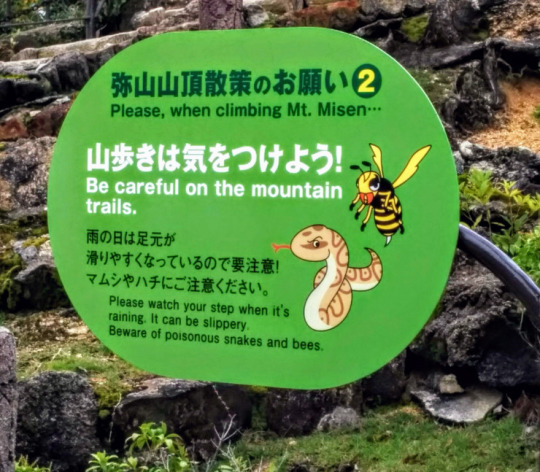
Watch out for snakes.
Speaking of oysters, the island is replete with shops serving oysters in a variety of ways. My personal favorite is a fried bread roll with two oysters in curry sauce stuffed inside. It’s probably the least healthy way to eat an oyster, but damn, it is soooo (yes, 3 extra o’s) good. I must confess though, I am not the best person to ask when it comes to food. When I travel, I tend to just kind of forget about eating until it is completely necessary. I’m not a foodie, hate that word by the way. Nor do I make it a point to try every bit of food that just happens to be in a certain country or city. So there may be better food out there, just don’t ask me for advice. All of my coworkers tell me I must try this or eat that when I go to X. Maybe it is a Japan thing. Upon hearing I was traveling to Hiroshima, I had a plethora of coworkers tell me that I must, MUST, eat okonomiyaki while in Hiroshima. I generally don’t cave to pressure, but I kind of felt like that if I didn’t try the Hiroshima okonomiyaki, I may lose my job.

Veni, vidi, voravi.
So, there it is. The famous okonomiyaki. I had the oyster with squid chips. Even though I had to wait about an hour, it was definitely worth the wait. I recommend you try out Nagata-ya. It is conveniently located right next to the Memorial Park. I’m not getting any money for this plug by the way.
If history and food aren’t your things, why are you in Japan? But really, if you don’t care about castles, shrines or food, then I highly recommend you check out Mazda Zoom Zoom Stadium to watch the local 9 play. The Hiroshima Carp are not just another diversion, they are more like a religion and Mazda Stadium is the temple.

The view from the visitors cheering section.
In the megacities of Tokyo and Osaka, there is an infinite number of ways to spend your entertainment Yen. Baseball fans in these cities also have a choice in which side they will pledge their allegiance. Tokyo has the Giants and Swallows. Osaka has the Buffaloes and Tigers. Hiroshima has the Carp and the Carp alone. On game days, the stadium is a veritable sea of red. There must be a city ordinance or unwritten rule that states fans must wear a jersey to the game or at the very least a red T-shirt. The fans pack the stadium all summer. In fact, it can be difficult to get a seat. Book ahead if you want to sit with the Carp fans. Failing that, you can sit with the visiting team fans in their section. The seats are fine, but you can’t wear Carp colors for obvious reasons, and it is just more fun to sit with the home fans.
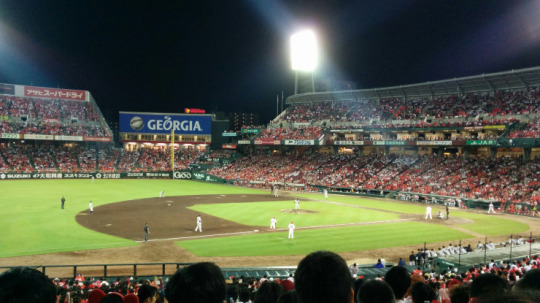
Lucky to get a seat along 3rd base.
The gameday experience officially begins at Hiroshima station. Tables and booths pop up seemingly from out of nowhere. The variety of goods on offer is astounding. Hats, jerseys, scarves, fans and other items too numerous to list here. The one thing they all have in common is that they are red and emblazoned with the Carp logo. While some booths specialize in fan merchandise, the remaining specialize in food and beer. You could eat a five-course meal and get completely sloshed during the 1.5 km walk to the park. Even if you are not a fan of baseball, I guarantee you will have a great time at a Carp game. Japanese baseball is much more than just the game. The fans are completely engaged and are probably more exhausted than some of the players by the end of the game. If you get the chance, you really need to check out a game in Hiroshima.
There is much more to see in Hiroshima and I’m already planning next trip. If you do make it to Japan, you owe it to yourself to check out this picturesque city of just over 1 million. After the crush of Tokyo or Osaka, you will come to appreciate this more laid-back but fun city.
This slideshow requires JavaScript.
This slideshow requires JavaScript.
Some shots of Daisho-in. There is said to be a flame that has been burning at this temple for more than 1200 years. The small statues are the disciples of Shaka Nyorai (The Buddha). Each of the 500 statues has a unique expression.
This slideshow requires JavaScript.
広島 – My favorite city in Japan. Tokyo is the bustling capital. Osaka is the wild port city. Kyoto is the former capital and now historic heart of Japan.
0 notes

